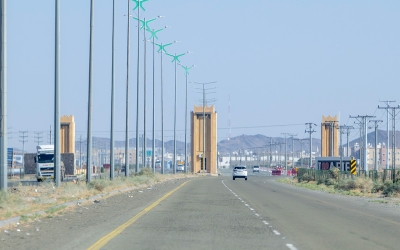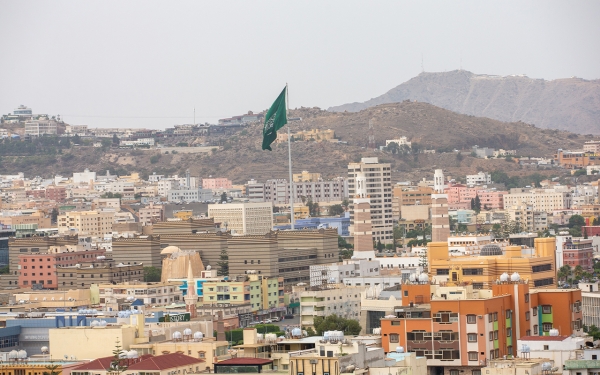
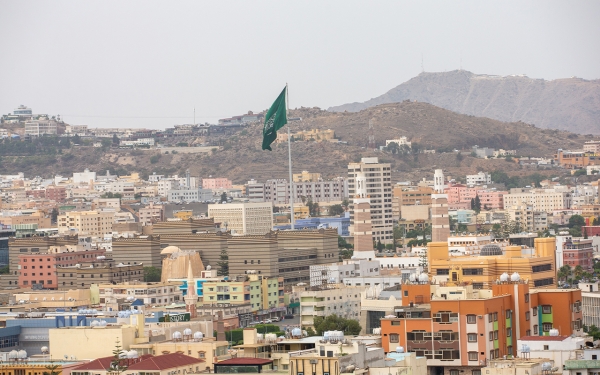
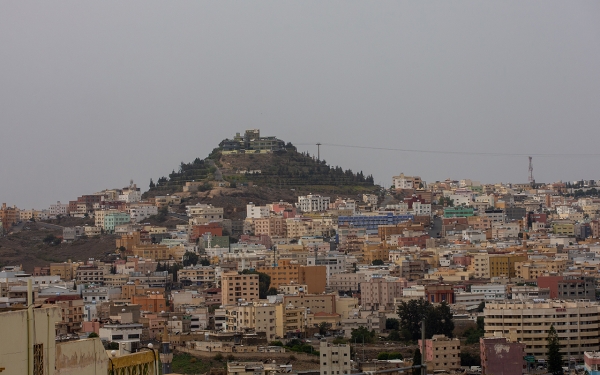
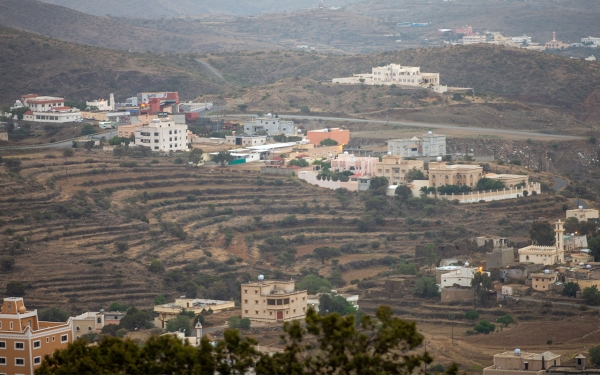
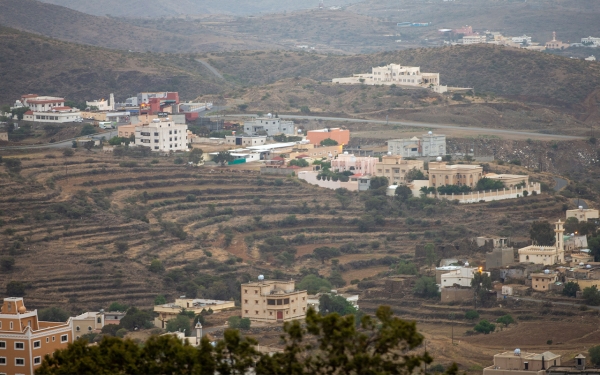
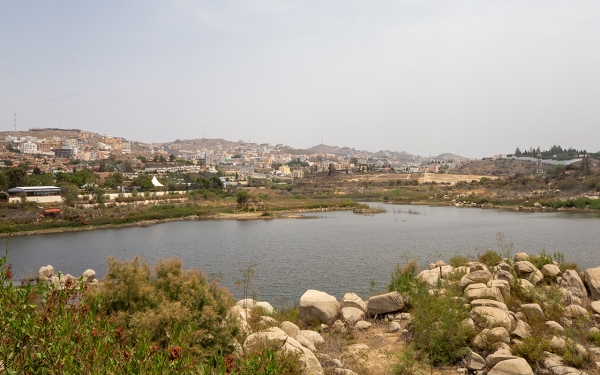
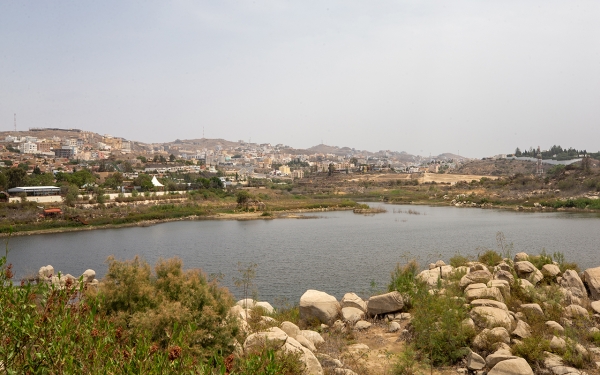
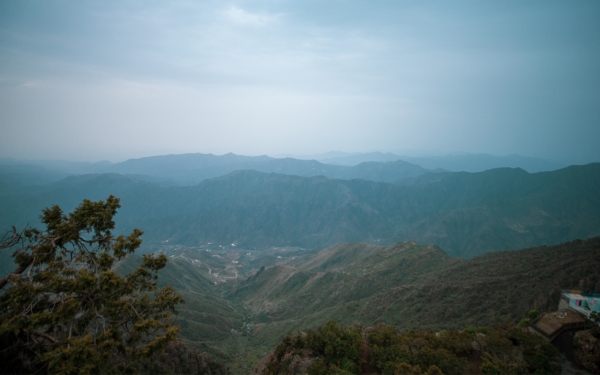
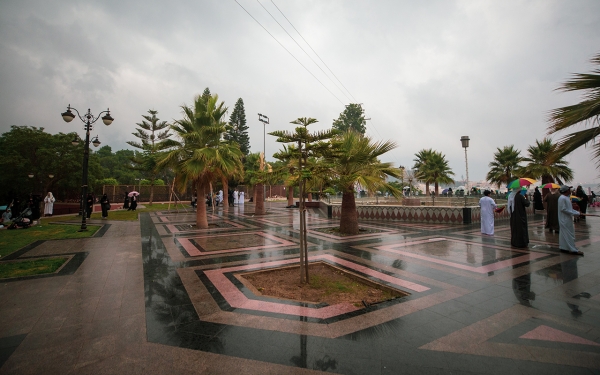
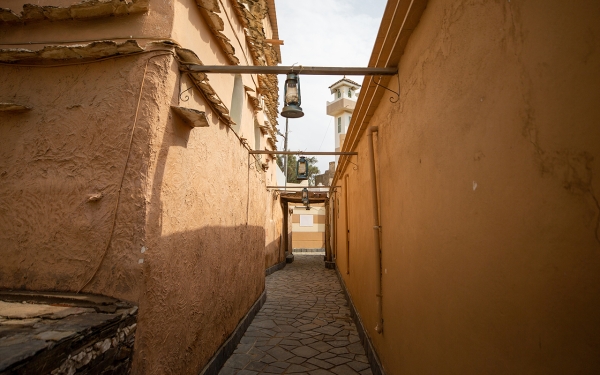
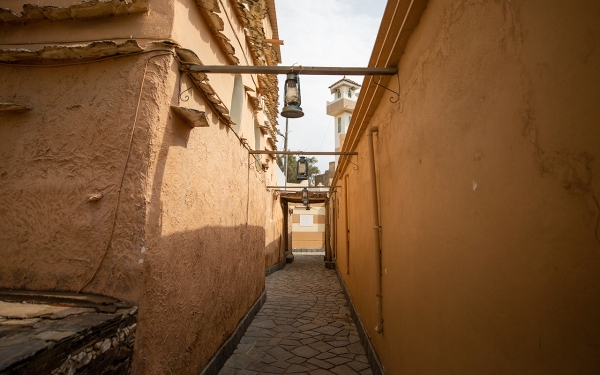
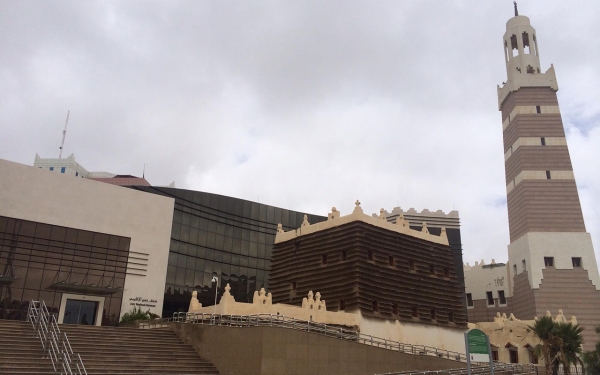
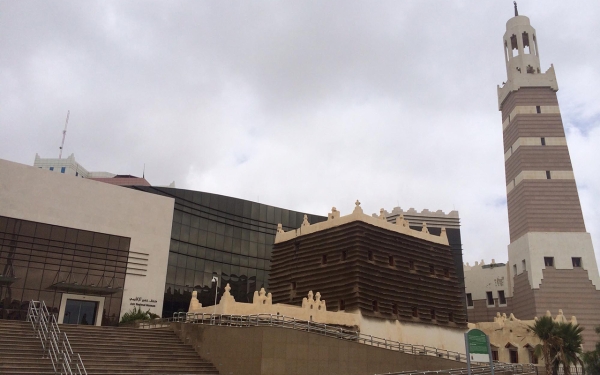
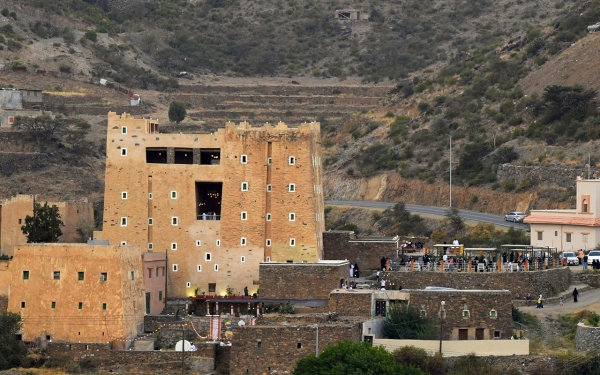
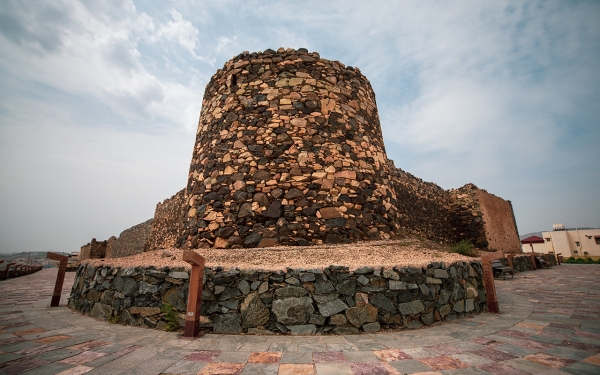
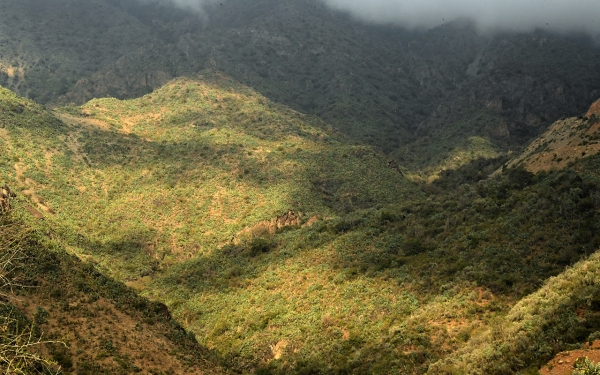
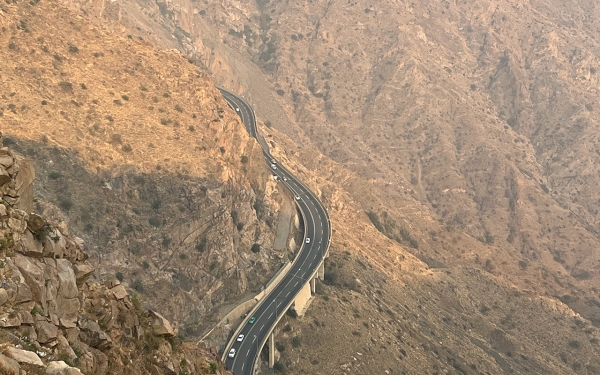
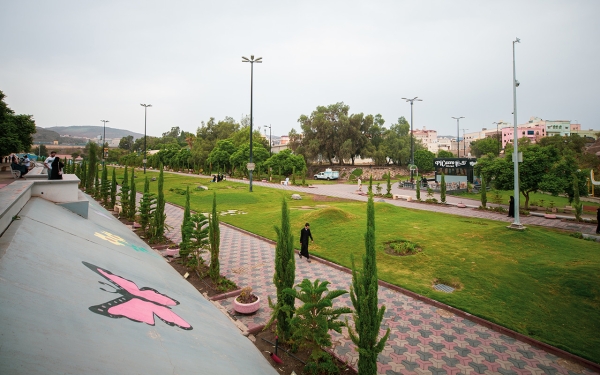
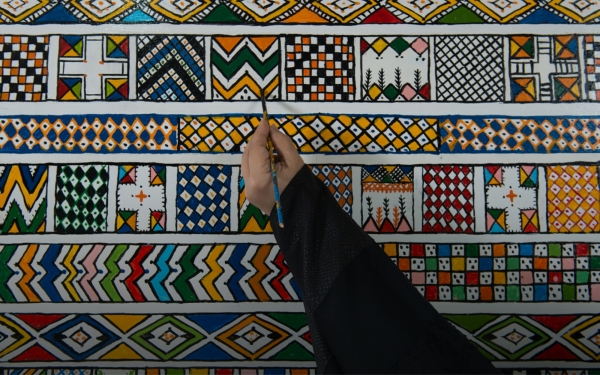
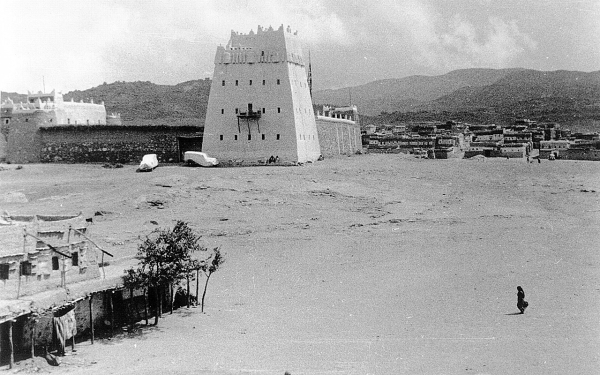
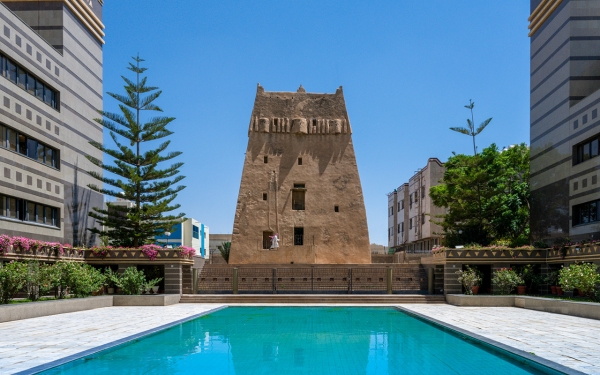
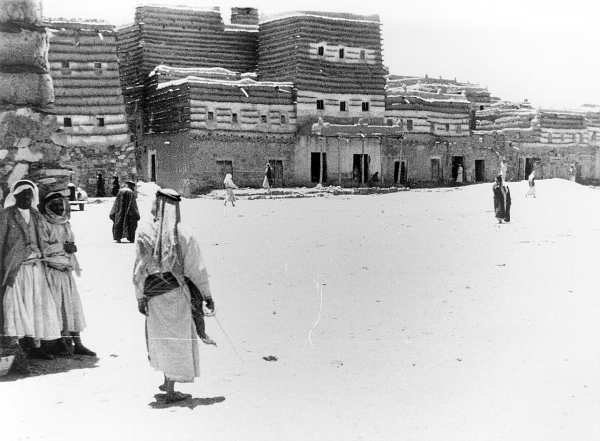
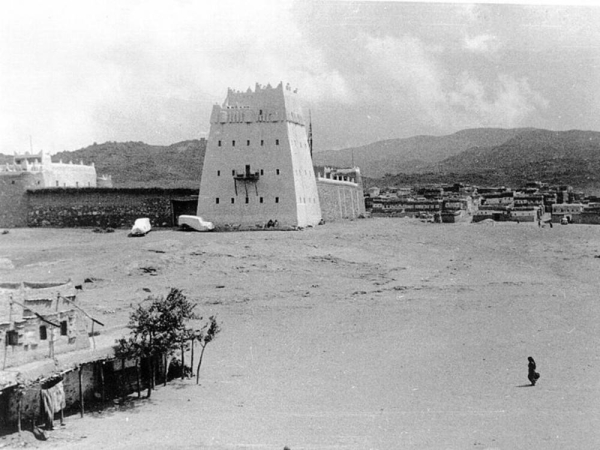
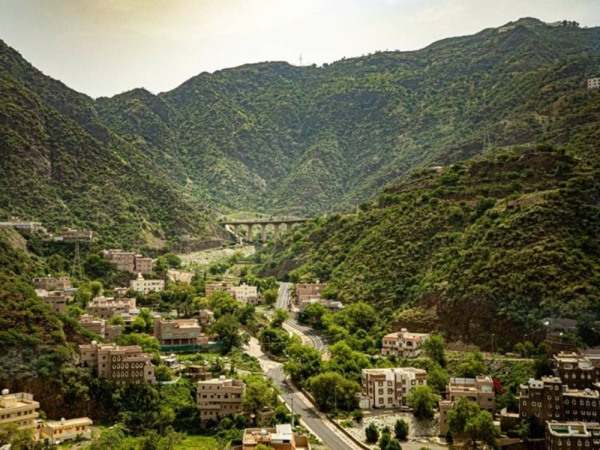
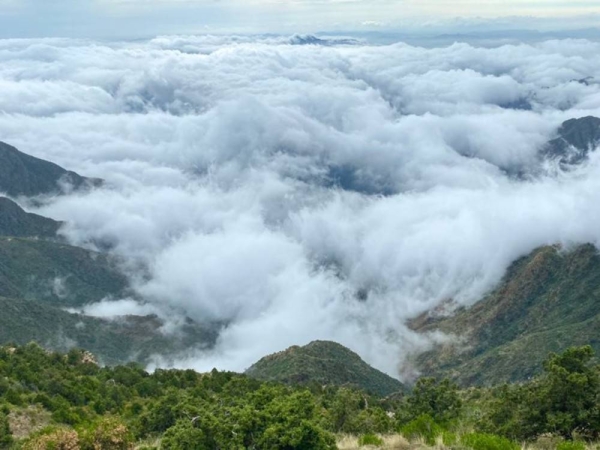
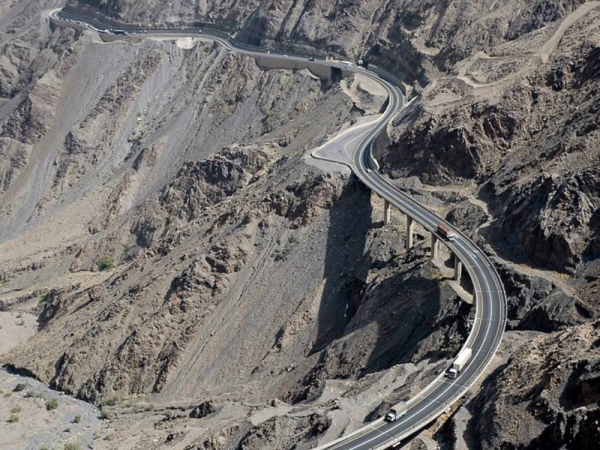
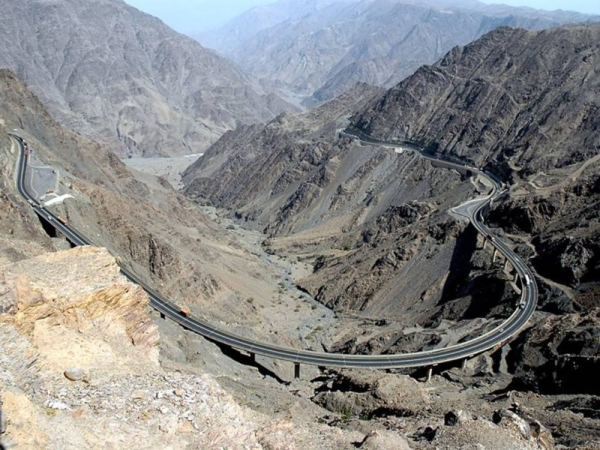
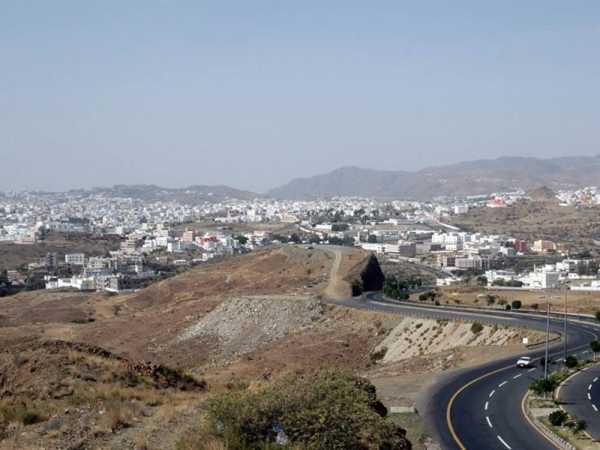
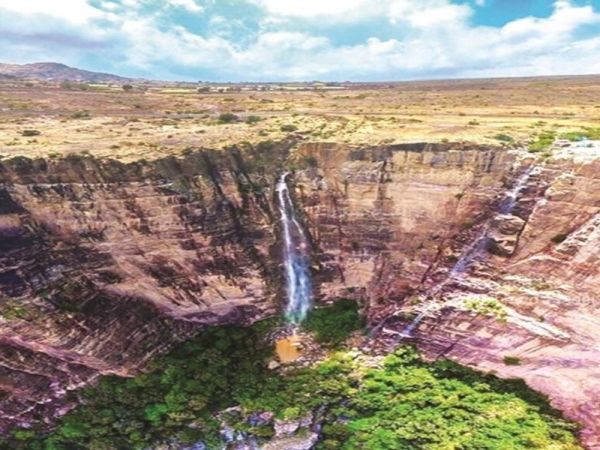
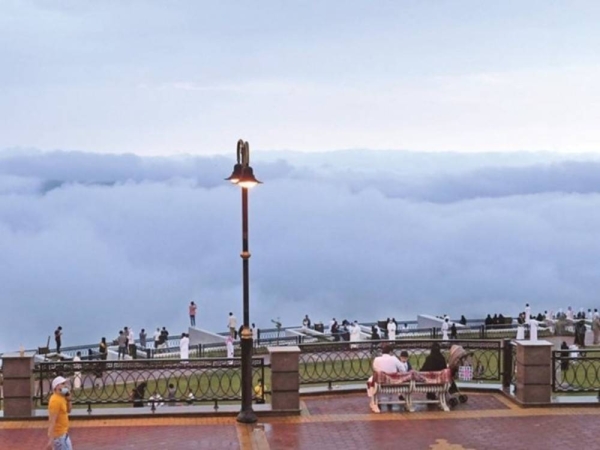
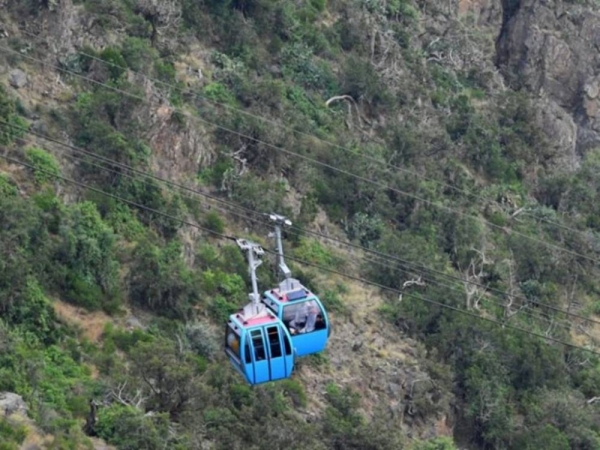
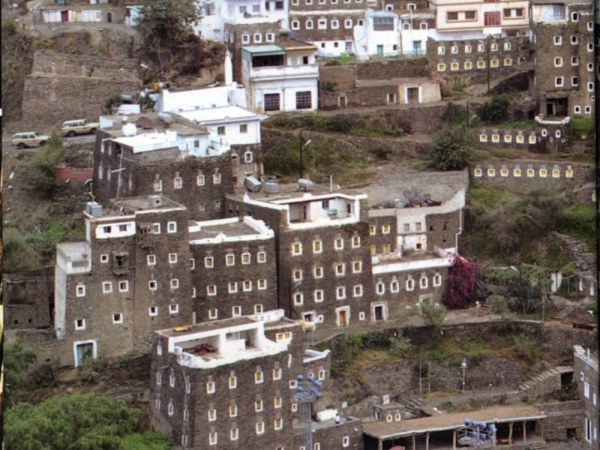
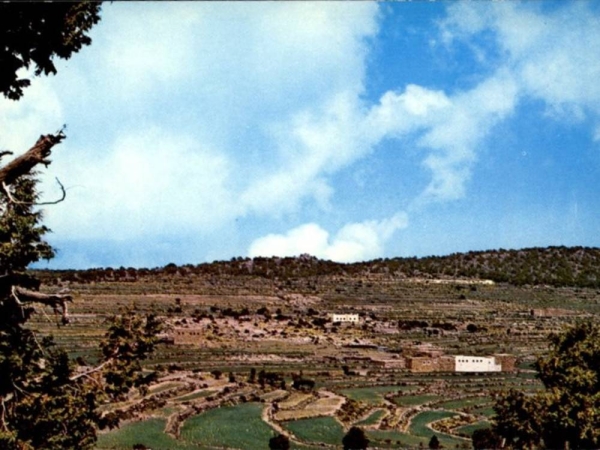
Abha City (romanized: Abhā), the administrative capital of Aseer Province in the southwest of the Kingdom of Saudi Arabia, is a mountainous city that sits at the highest elevation in the Kingdom.
Referred to as Arus al-Jabal (Bride of the Mountain), Sayidat al-Dabab (Lady of the Fog), and Abha al-Bahiya (Beautiful Abha), the city has been a prominent tourist destination since the 1980s, hosting various festivals and events that draw in over two million visitors each tourist season. Abha is also steeped in heritage and culture, with approximately 542 heritage villages. In 2017, Abha City was chosen as the capital of Arab tourism. It boasts a range of notable tourist attractions, such as al-Soudah Mountains, Mount Dhara, known as the Green Mountain, Abha Dam, al-Sahab Park, the Fog Walkway or al-Dabbab Walkway, Airport Park, al-Rawdah Walkway and Garden, and the gardens of Sama Abha. Additionally, there are cable car trips between the new Abha station, the Green Mountain, Abha Dam, and Abu Kheyal Park. Another route departs from Jibal as-Sudah at an altitude of 3,015 m down towards the village of Rijal Alma.
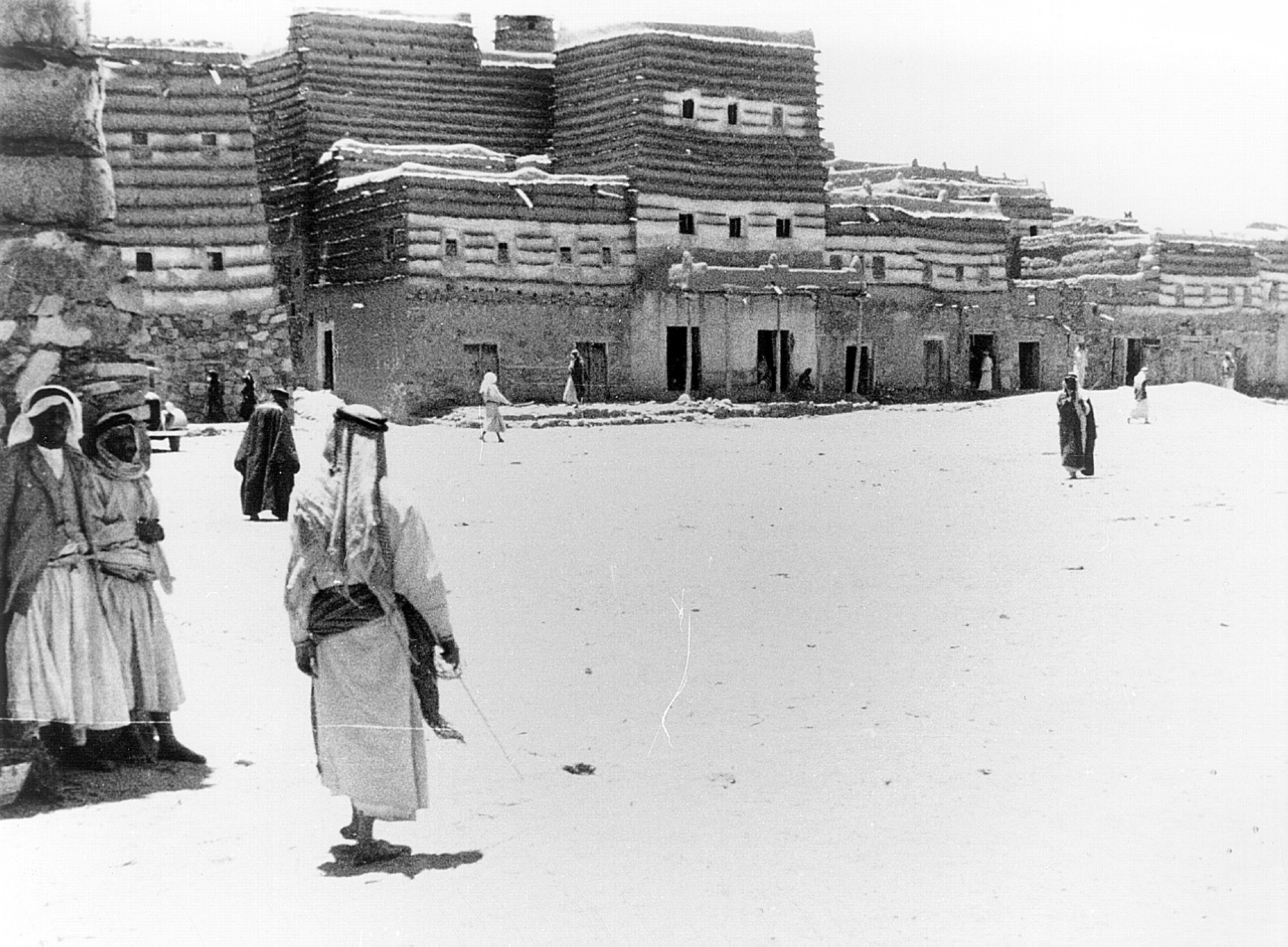
A historical overview of Abha City
The naming of Abha
Historically, according to certain researchers, Abha was previously known as Abqa. This was the site from which Queen Bilqis's camels carried gifts to the Prophet Suleiman, peace be upon him (PBUH). Previously, Abha was composed of a collection of neighborhoods, exceeding forty in number. At its center was a central village named Manazir. Later, these neighborhoods interconnected, forming what is now known as Abha.
Abha's ancient neighborhoods
In 1827, Prince Ali Bin Mujthil al-Mughidi designated Abha as the capital of the Emirate of Aseer, replacing Umsqa. Abha gradually expanded and became more urbanized. Several of its neighborhoods gained prominence, such as "Manazir," which served as the foundation for the development of other areas, "al-Qura," "al-Rubu'," "Na’man," "Maftaha" in the southwest, "al-Khasha" in the southeast of Abha, "Muqabil," also known as "Umm Qabel," in the northwest, and "al-Nusab" behind the Manazir Neighborhood.
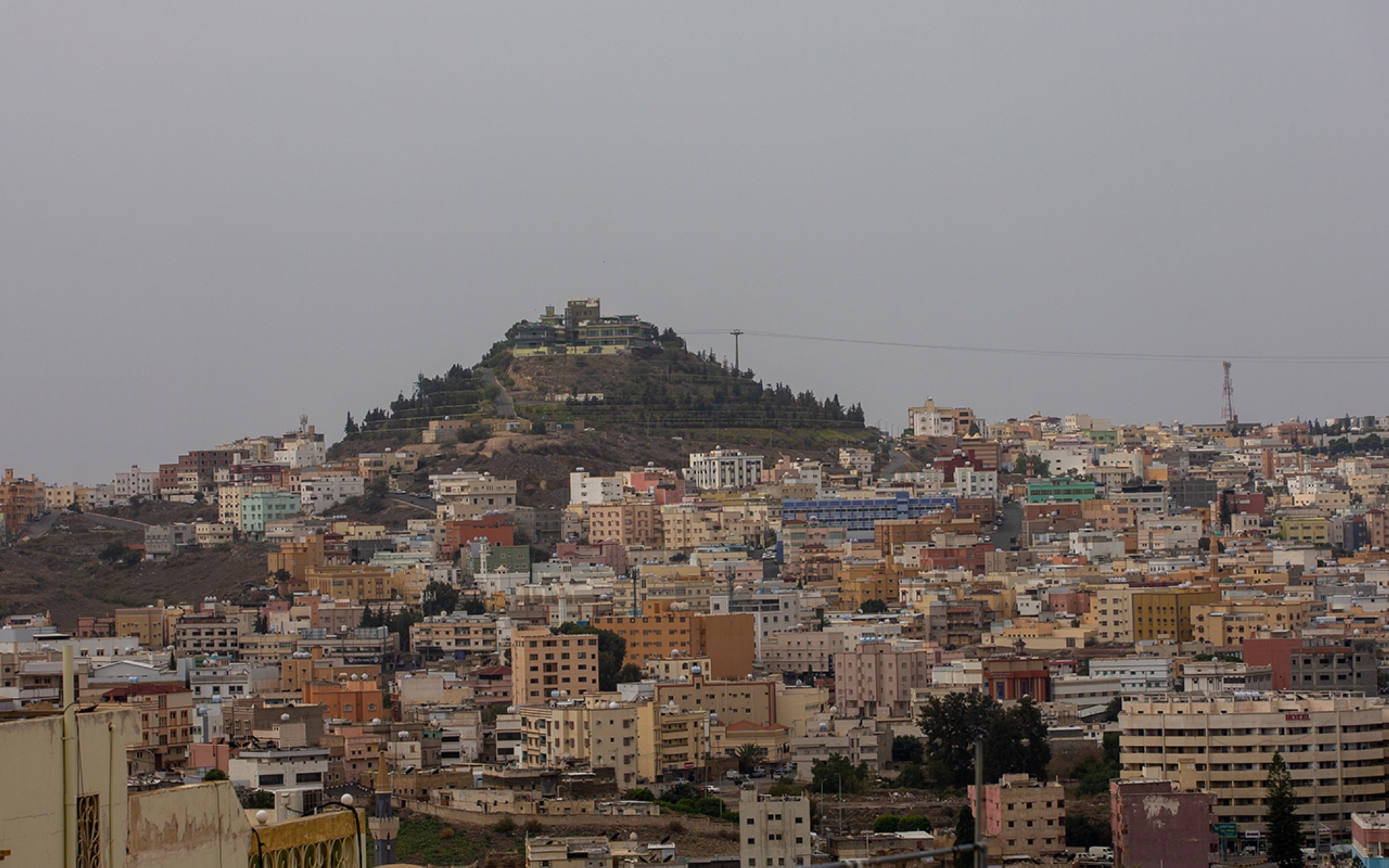
Traditional architecture in Abha City
Abha is characterized by its traditional architectural style, which blends both the clay and stone styles. The facades of its buildings are adorned with al-Qatt al-Aseeri art. The colors of its stone buildings vary depending on the type of stone used in construction, as the region is abundant in basalt, schist, granite, and diorite rocks. Each building is composed of two to three floors. The first floor is made of stone, and the remaining part of the building is made of clay mixed with rock slabs. The base of the house is wider than the top, and shelves of schist align on its external walls. These walls have a slight incline downwards, facilitating the drainage of rainwater.
Geography of Abha City
Location and borders
Abha City is located in the central-western part of Aseer Province. Administratively, its territory is divided into four sections, three of which fall within al-Sarah area. These are: The northern section, bordered by Khamis Mushayt and Bishah Governorates to the east, by Mahayel and Bariq Governorates to the west, by Tanumah Governorate to the north, and by Mahayel and Khamis Mushayt Governorates to the south. The central section is bordered by Khamis Mushayt, Sarat Abidah, and Ahad Rufaydah to the east, by Rijal Alma Governorate to the west, by Khamis Mushayt and Mahayel Governorates to the north, and by ar-Rayth Governorate, administratively affiliated with the Emirate of Jazan Province, to the south. The southern section is bordered by Dhahran al-Janub Governorate to the east, by ad-Da'ir Governorate, administratively affiliated with the Emriate of Jazan Province, to the west, by Sarat Abidah Governorate to the north, and by both ad-Da'ir Governorate and the Saudi border with Yemen to the south.
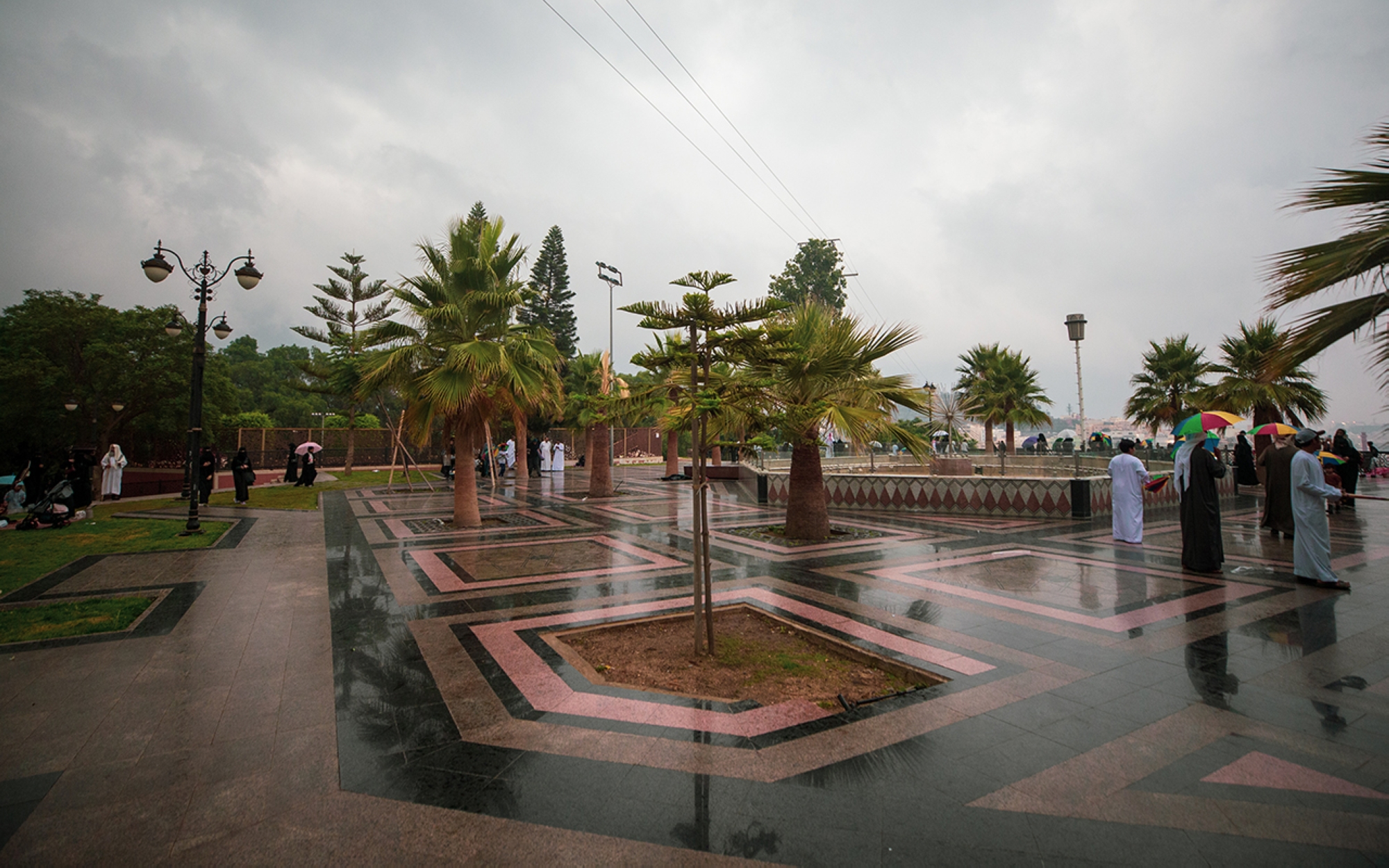
The climate in Abha City
Geographically, Abha City is situated on the Sarawat Mountains; its climate is characterized by moderate temperatures in the summer and cooler temperatures in the winter. The average maximum temperature in winter is fourteen degrees Celcius, with an average minimum of six degrees Celcius. In the summer, the average maximum temperature is twenty-six degrees Celcius, and the average minimum is sixteen degrees Celcius. Abha receives the highest average rainfall in the Kingdom. The highlands receive more rainfall than the slopes, with an annual average ranging between three hundred mm and 470 mm. Humidity increases in the winter, with an average relative humidity of 74 percent. During the summer, the humidity is more moderate, with an average relative humidity of 54 percent.
Demographics of Abha City
The population of Abha City has rapidly increased over the past four decades. In 1974, the city's population was 31,000, which rose to one hundred thousand by 1986. By 1992, the number had more than tripled to 102,320 residents. In 2010, the population reached 240,000, and by 2016, the number had grown to 420,000. This makes Abha the second-largest city in terms of population after Khamis Mushayt Governorate in Aseer Province, accounting for 29.7 percent of Aseer Province's total population. According to the 2022 Saudi census, the city's population stood at 422,243, which represents 20.9 percent of the total population of Aseer Province.
Abha City is one of the focal points of regional development in the Kingdom and is the most active area in the south of the Kingdom. The city primarily relies on tourism, agriculture, and trade activities for its revenue. Agriculture, government administration, and wholesale and retail trade provide a significant portion of employment opportunities in Abha.
Agricultural terraces
Agricultural terraces have been shaped from significant parts of the mountainous terrains, slopes, and elevations in the province. These terraces serve to preserve agricultural soil and retain rainwater, which historically was the primary source for irrigating crops. The terraces vary in their levels, also known as Rakib, ranging from five to ten levels, some stacked above others.
Each terrace stands at a height between half m to two and a half m. There are several types of terraces, including short flat terraces suitable for slopes, each between three and six m in length; longer flat terraces divided by earthen barriers spaced three and four m apart; crescent-shaped basin terraces that are highly eroded; sloped terraces with channels designed to divert excess rainwater, sloping to guide stagnant water into a watercourse; and layered terraces that have a slight incline, aligning horizontally.
Agricultural wealth
The agricultural sector in Abha City focuses on producing certain types of summer fruits such as figs, pomegranates, grapes, peaches, apples, and oranges. It also concentrates on harvesting crops from mountainous regions, including wheat, barley, millet, and white corn. Additionally, strawberry cultivation is prominent in Abha, with around 308,000 seedlings, according to estimates from the branch of the Ministry of Environment, Water, and Agriculture. Strawberries are characterized by their rapid growth and ease of cultivation, with minimal irrigation requirements. If the appropriate climatic conditions are provided, they continue to produce for a period of three years.
The cultivation of roses and the extraction of aromatic plants are significant tourist attractions in Abha City. The city boasts the largest rose farm in its north, covering an area of about 250,000 m². This farm cultivates more than forty million roses annually, from which various perfumes are derived, such as rose water, rose perfume, rose oil, and other rose-related products like creams. The farm also includes a distillation facility dedicated to rose extraction, producing approximately 120,000 packages annually.
For centuries, Abha City has been known for beekeeping and producing some of the finest honey, relying on its diverse climate and geography, as well as the availability of trees upon which bees feed, such as Acacia, Ziziphus spina-christi, Acacia tortili, Salvadora persica, and Rhanterium epapposum. This results in the production of top-quality honey varieties like the money from Ziziphus spina-christ, Majra, Parkinsonia aculeata, Flower Honey, Acacia ehrenbergiana, and Acacia tortili. Beekeepers in Abha adhere to the standards of maintaining bee colonies. The number of beehives in Aseer Province amounts to approximately 1,809,920, while the number of beekeepers is around 5,656, according to the estimated statistics of the branch of the Ministry of Environment, Water, and Agriculture in Aseer Province for 2018.
The Ministry of Environment, Water, and Agriculture supports beekeepers to produce local honey known for its high quality. They provide them with licenses that enable them to obtain agricultural loans, recruit beekeepers, benefit from the central bee laboratory in Riyadh, and offer advisory services. In Abha City, a Honey Festival is held where the finest types of honey are showcased and marketed. This allows potential buyers to examine and ensure the quality of the honey they wish to purchase. Concurrent with the festival, workshops and informative lectures on beekeeping are held.
Archaeological landmarks in Abha
Recent Stone Age sites
In Aseer Province, a significant number of sites from the recent Stone Age have been discovered, totaling eighteen sites. Jabal as-Sudah alone has two of these sites. Preliminary studies on the stone tools found at these sites revealed a notable resemblance between them and those discovered in Wadi Tathlith. These tools include arrowheads, flakes, blades, and polished stones made from volcanic glass or flint.
The archaeological Hadabat al-Arus
Located northeast of Abha City, Hadabat al-Arus is roughly seven km away. It gained its name due to its shape which resembles a slender-waisted woman with flowing hair. The Hadabat is a historical site comprised of rocks inscribed with numerous Thamudic engravings in various designs.
The natural environment of Abha City
Mount Tahlal
It is located about twenty km away from Abha City. It has several names, including Jabal Aseer, the Green Mountain, and Tur al-Ghamam. It has the highest peak within Aseer Province; as-Sudah peak, at 3,015 m. It extends from Rahma's peak in the south to the ridge of Rajam. Its vegetation is diverse, consisting of Juniper forests, wild olive trees, and Dodonaea. On the high slopes of Mount Tahlal, several valleys such as Wadi Tahlal and Wadi Qardah descend. Several agricultural villages are scattered around it, including the village of as-Sudah. The temperature remains moderate during the summer, not exceeding twenty degrees Celsius. The annual average rainfall ranges from three hundred to five hundred mm. Snow falls on its high peaks in winter, with temperatures dropping to zero degrees Celsius.
Mount Tahlal is known for its rich natural economic resources, such as iron. The people of Aseer used to extract sulfuric compounds that were used in the manufacture of knives, jambiya, daggers, swords, and the iron product, known as al-Ludma al-Tahliliya or al-Sahab al-Tahlali named after the iron ore in Mount Tahlal used in traditional manufacturing. Historically, Mount Tahlal was a site of resistance against invaders. Tami Bin Shuaib al-Mutahami confronted the Ottoman campaign in the region in 1813.
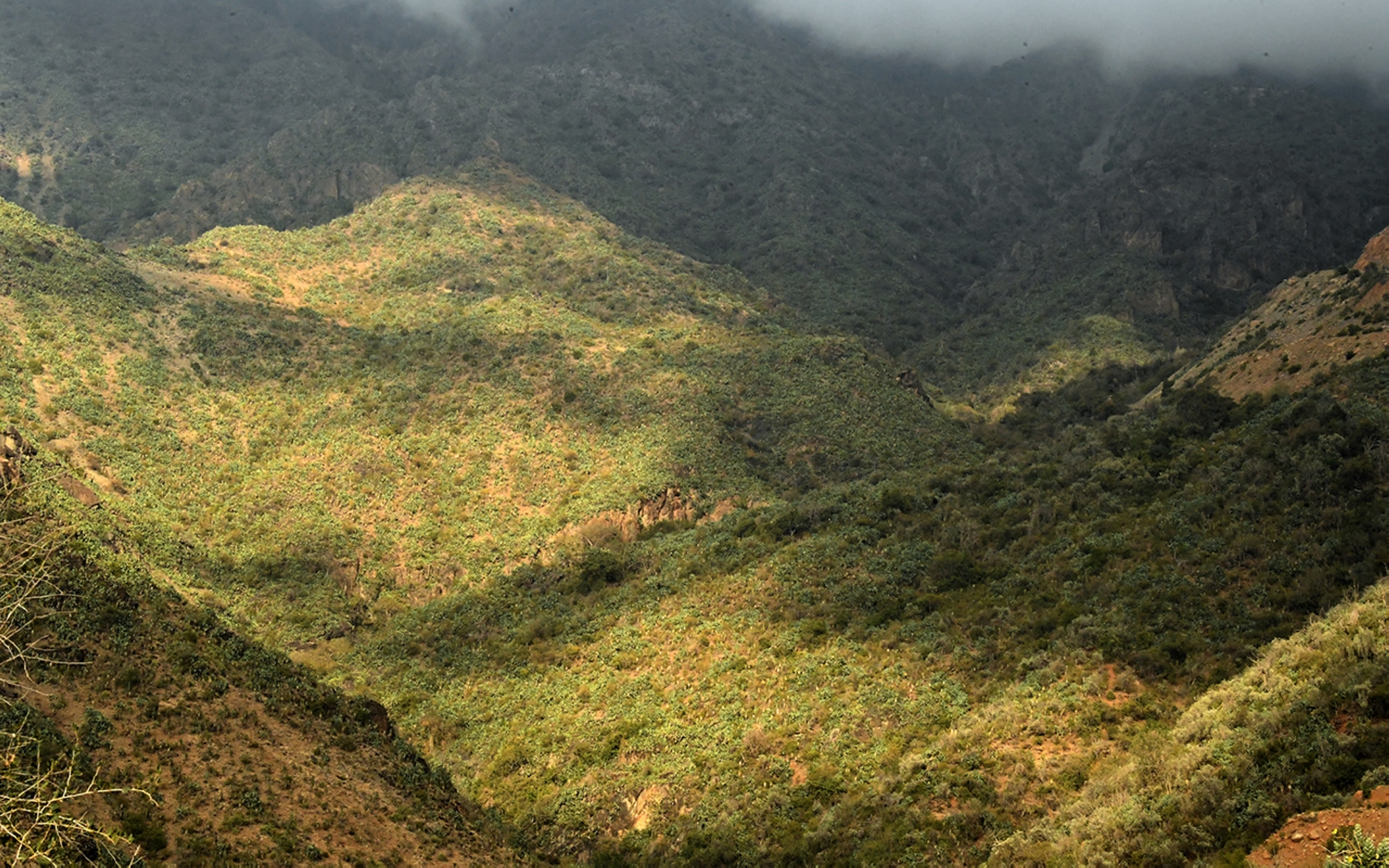
Raydah Natural Reserve
It is located between longitudes 42°22' and 45°29'E, and latitudes 18°14' and 18°22'N, near Aseer National Park. It is about twenty km west of Abha and sits at an elevation of approximately two thousand m above sea level. The reserve is part of the Arabian Shield, which consists of mobile igneous rocks and is bordered to the north by Jabal as-Sudah and al-Sahab Park. It spans an area of about nine km², with a perimeter of seventeen km. Its population engages in agriculture and herding, reflecting its nature as a small agricultural village.
The reserve retains its pristine natural environment due to minimal human intervention and the difficulty of accessing it. It is characterized by steep slopes covered with juniper trees, wild olive trees, and cacti. These plants provide a suitable habitat for various bird species. The lands of the reserve also host ferns and wildflowers. The reserve is home to twelve bird species native to the Arabian Peninsula, including the Arabian red-legged partridge, the Arabian woodpecker, the Aseer magpie, and the Arabian bulbul. In addition, there are several bird species of East African origin, such as the African grey hornbill, the African Nightjars, the hamerkop, the Abyssinian roller, and the small green bee-eater. It also shelters a few Arabian leopards and hosts species like the caracal, the wildcat, baboons, the Arabian wolf, foxes, striped hyenas, white-tailed mongooses, and rock hyrax.
Transportation in Abha City
Air transport
Abha International Airport serves as the gateway to Aseer Province, a tourist destination for many domestic and international visitors to the Kingdom. Established in 1977, the airport is located twenty-two km from Abha City. It handles both domestic and international flights in the Kingdom, and in 2019, it facilitated approximately 35,027 arriving and departing, international and domestic flights, with around 4,368,153 passengers.
Abha International Airport underwent an upgrade in 2019 to increase its passenger capacity. A new departure lounge was added, which can accommodate up to eight million passengers. Additionally, an aircraft parking area related to the new hall, service areas, and auxiliary buildings was established. It accommodates more than 222 flights weekly, comprising 188 domestic flights and thirty-four international ones. In 2020, the airport's status was elevated from regional to international after meeting all the conditions, specifications, and standards set by the International Civil Aviation Organization. Abha International Airport managed to achieve second place globally in the category of small airports for punctuality in departures and arrivals for 2018, according to the global site OAG, a specialized platform for rating airports and airlines.
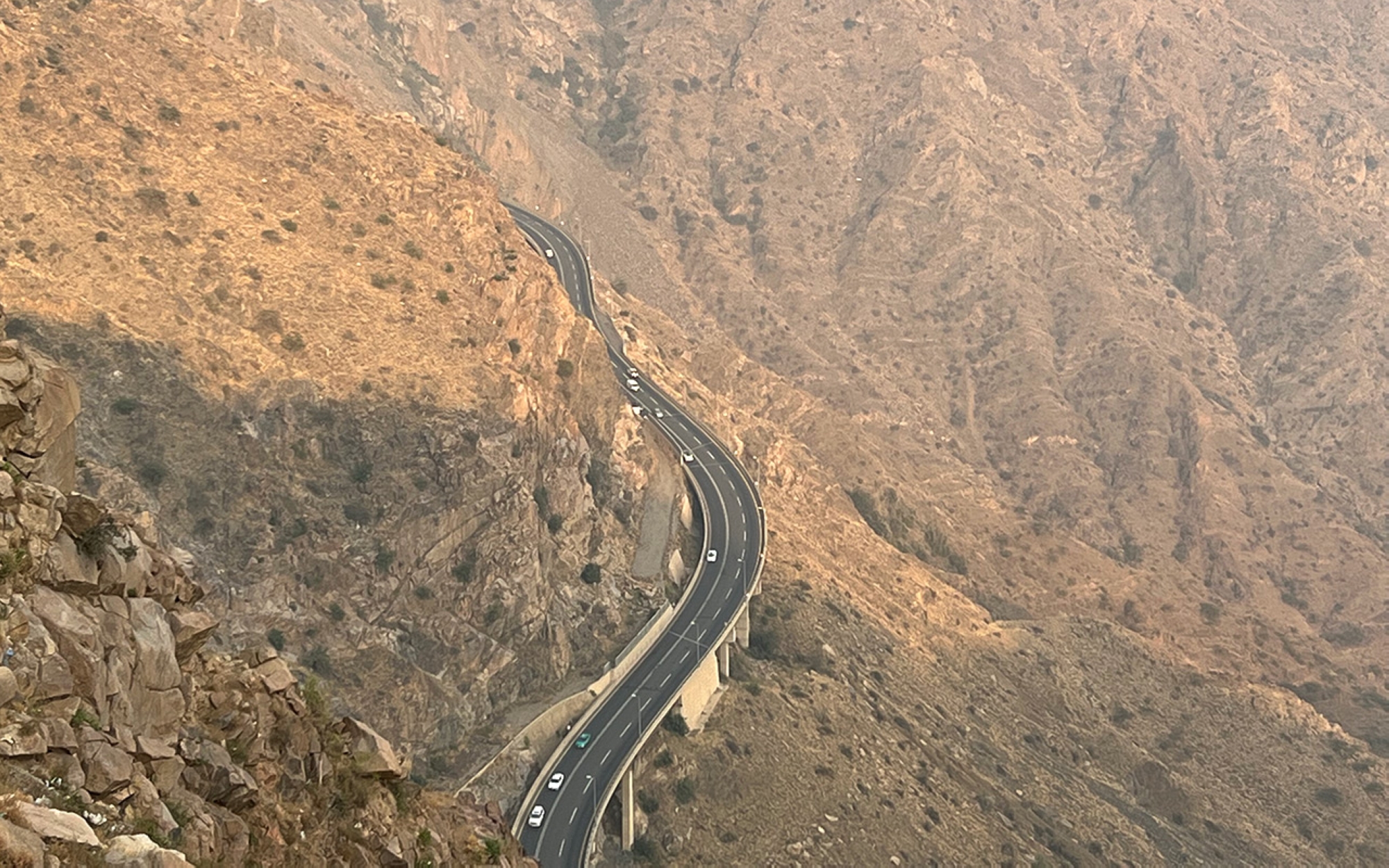
Land transport
Abha city is connected to other Saudi cities through key roads. These are al-Taif - al-Bahah - Abha - Jazan route, a major highway established between 1971 and 1975, spanning 750 km, and passing through various urban centers. There is also the Bishah route (or the Wadi ad-Dawasir route) connecting Abha to Riyadh. Additionally, the Jeddah-Jazan coastal road, constructed in 1979, runs through Aseer Province.
Abha City has seen several road development projects, including an intersection project for the Abha - al-Fara' road with King Abdullah Road, the development project of Prince Sultan Road on the ring road, and the doubling of as-Sudah Road, which is crucial for its connection to the tourist-favorite as-Sudah Village. The project was completed in two phases, with the first stretching ten km and the second eleven km.
Bus transportation project
In collaboration with the Transport General Authority and the Municipality of Aseer Province, the Aseer Development Authority announced the launch of a public bus transportation project in Abha, Khamis Mushayt, and Ahad Rufaydah, set to commence in early 2024. The project will rely on thirteen routes and fifty-five buses. The Municipality of Aseer Province is responsible for the infrastructure development of the project and its operation according to the Transport General Authority's requirements.
The project encompasses thirteen routes, spanning a distance of 321 km, including 196 bus stops and approximately fifty-five buses. These buses are driven by over 150 drivers over an eighteen-hour operational day. A team, comprising members from the Transport General Authority, the Aseer Development Authority, and the Municipality of Aseer Province, was formed to ensure that the public transportation network aligns with strategic and regional plans in the province. They have also worked to ensure it is suitable for the existing road features and have conducted field visits to inspect bus stops and routes.
Cultural heritage in Abha City
Al-Masqi Village
It is situated approximately thirty-three km south of Abha City and three km south of King Khalid University, near the road connecting Tamniyah and Abha. It historically served as a transit station for travelers heading to Makkah al-Mukarramah, al-Madinah al-Munawwarah, and the Levant. The village is surrounded by farms on its outskirts and was traditionally protected with doors that were opened in the morning and closed at dusk.
The village consists of interlinked residential buildings that are closely packed together, each with multiple floors. Narrow pathways separate these structures. Within the village, there's an ancient mosque believed to be hundreds of years old. The village also has most of the essential amenities like mosques, schools, a police station, a post office, and a health center. Homes in al-Masqi Village were constructed using clay and stone. They were roofed with trunks from trees like juniper, Vachellia tortilis, and acacia. Over these trunks, reeds were laid and then topped with a layer of clay, ensuring that rainwater did not penetrate inside.
Al-Akas Village
It is situated to the west of Abha City on a peninsula encircled by the Tahlal Valley. As one of the largest and oldest heritage villages in Aseer Province, it boasts a history spanning over three hundred years. The village boasts several war castles, fortresses, heritage buildings, palaces, and multi-story houses. It has a rich history, including its renowned system of Kadam, which is a method for water distribution. This system was employed to irrigate farms and to allocate water among farmers equitably based on the size of their agricultural plots. There's also a feature known as al-Hassu, designed for watering livestock and animals. It is characterized by its systematic distribution in its pathways and content.
At the center of the village stands a heritage mosque. The village's castles and fortresses are meticulously distributed towards the north. Starting from its public squares, known as al-Kuthban, it extends to al-Marhab, called al-Mashu'a, a spacious, level area designated for receiving village guests and hosting both formal and traditional social events, ending at Zahwan. The village is also distinguished by the abundance of al-Jarn, which is a station whose location is carefully chosen to ensure it is free from wind barriers and is oriented towards the eastern and western wind directions. Al-Jarn is used for threshing and filtering grains after harvesting from the farms, with the Munzaf situated at its end.
Al-Akas Heritage Village has been distinguished with its education for centuries. It is home to Katatib (schools)that have produced scholars, judges, writers, thinkers, and military leaders. The village's grand mosque stands as a beacon of civilization, culture, and education.
As part of the Humanizing Heritage Villages project implemented by the Municipality of Aseer Province, development efforts included the rehabilitation of al-Akas Village. This involved work on al-Badi Museum, al-Akas Heritage Library, the village's grand mosque, the ancient mosque, the local market, pedestrian walkways, and climbing routes.
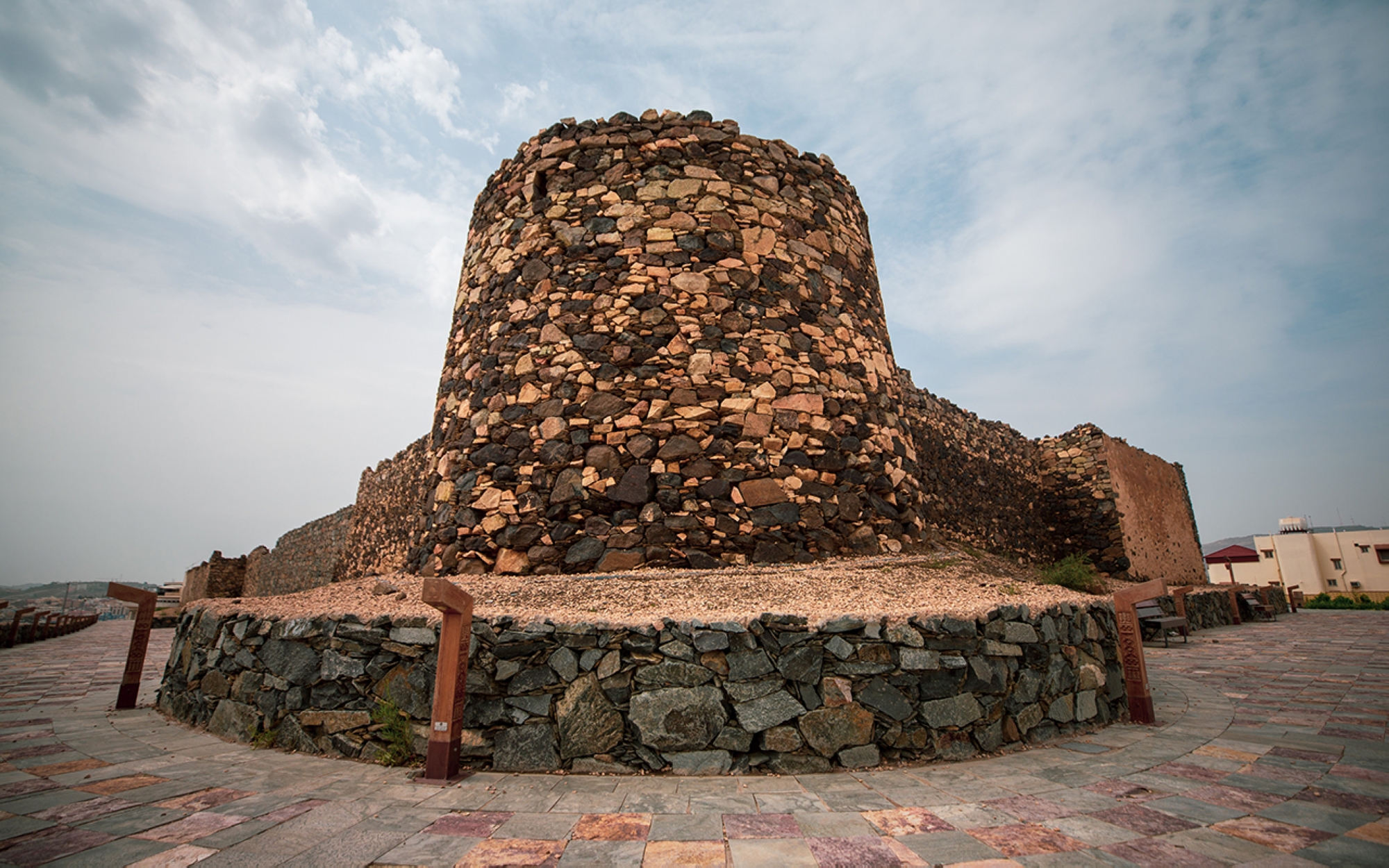
Shamsan Castle
It is a tourist landmark in Abha City, situated on the northeastern side of the city atop Shamsan Mountain, which stands at approximately 2,277 m above sea level. With a history spanning over a century, the site covers an area of about 5,389 m. It underwent restoration in 1933.
The main entrance of the castle spans about four m in width and is located in the middle of the southwestern wall overlooking Abha. This entrance leads to a covered corridor with two rooms designated for the guards. Inside, the castle features several rooms intended for soldiers, a rectangular courtyard, and various amenities, including restrooms and horse stables. Notably, the castle has three defensive towers located at only three of its corners, setting it apart from other forts that typically have four towers, one at each corner. In the northern corner of the castle stands a circular tower with a diameter of 4.8 m.
The design of the castle is irregular; its walls are built from uneven volcanic stones, with some parts plastered, mirroring the mountain upon which it was constructed. Over time, the ceilings of some rooms have collapsed. They were originally built using juniper tree logs, topped with dried reed sticks, and then layered with clay.
Al-Basta Heritage District
It was formerly a part of the villages that constituted Abha City, and it remains one of the well-preserved heritage districts of the city. Situated on the banks of Wadi Abha, it is connected to the opposite bank via the historic al-Qabil Bridge. The district's lanes are lined with heritage buildings centered around a public square and traditional commercial shops.
Al-Nasb Heritage District
It is situated in the heart of Abha City, along the banks of Abha Valley. The district is home to numerous palaces, old buildings, and passageways, all distinguished by their construction in the traditional 'Raqf' method, reflecting the old architectural style of Abha City. Among its historic landmarks is al-Nasb Mosque, originally built by Mohammed al-Mufreh I in 1690 in the Sarat style, and later reconstructed by his grandson, Sheikh Abdullah Bin Ahmed al-Mufreh, in 1862.
The mosque was constructed using mud and stone, with ceilings made of juniper tree trunks. It encompasses the ancient prayer area and covers a space of approximately 281 m², accommodating up to eighty-seven worshippers. Furthermore, a modern prayer area was constructed to the south of the mosque. This new addition was built using blocks and concrete. It features an open courtyard, restrooms, ablution facilities, a guard room, a storage room, and a square-shaped minaret that stands at a height of approximately 11.92 m. Following the renovation of the mosque as part of the Prince Mohammed Bin Salman Project for the Development of Historical Mosques in the Kingdom, the mosque was expanded to include a prayer hall, mosque courtyard, and ablution areas. It now accommodates up to 117 worshippers.
Abu Malha Palace
Abu Malha Palace epitomizes the distinct architectural style of Aseer Province and stands as a museum representing the traditional Aseeri household with all its possessions. Located in the heart of Abha City, on the edges of al-Bahar Square, the palace comprises four floors, covering an area of approximately 3,200 m². Its structure remains in good condition, especially after its restoration, and it has become a part of the Aseer Regional Museum. The palace belonged to Sheikh Abdulwahab Abu Malha, whom the founder King Abdulaziz Bin Abdulrahman Al Saud entrusted with managing the state treasury (Bayt al-Mal) in Abha in 1923. The palace was built by local hands, specializing in the architectural style of Aseer Province. The palace lacks battlements and defensive fortifications, as it was constructed during the Saudi era marked by security and stability. Abu Malha Palace is a prominent landmark in Aseer Province. It features architectural elements and white plaster decorations in various shapes on its facades and balconies. Both its interior and exterior walls are adorned with geometric and botanical patterns and motifs.
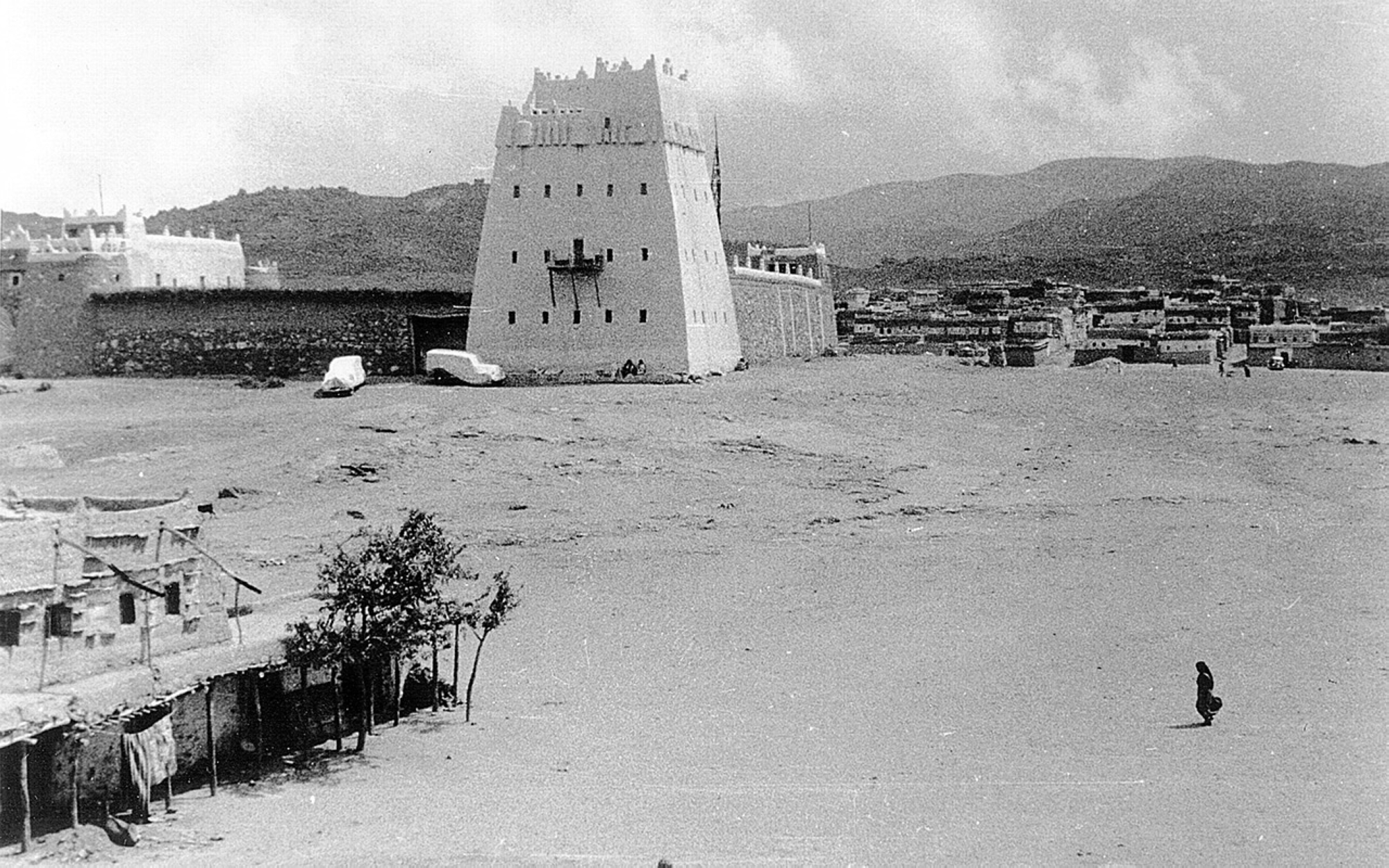
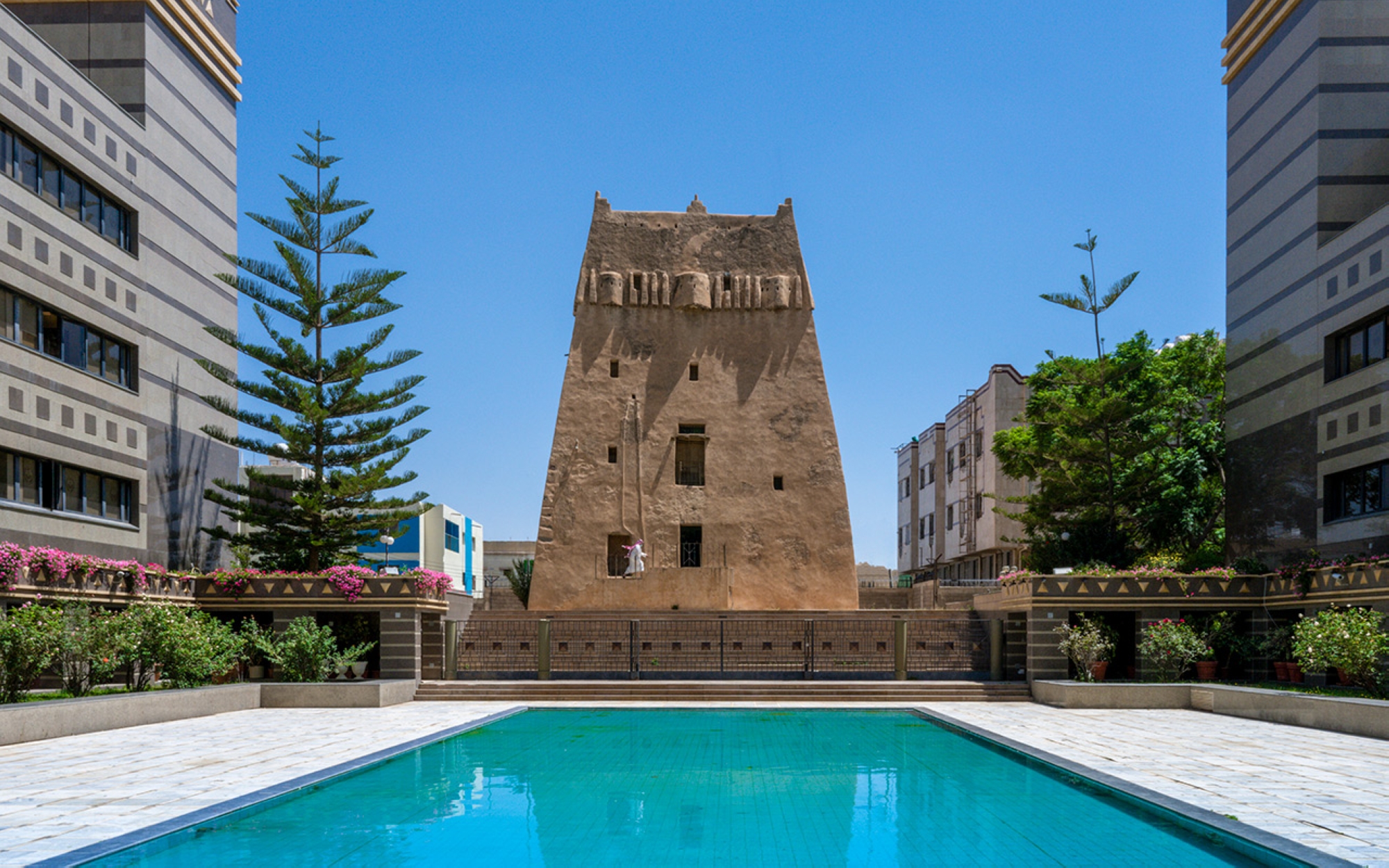
The Historical Shada Palace
Also known as the White Palace, it is an ancient structure that once served as the headquarters for the Emirate of Aseer Province for a period of time. The palace houses a museum dedicated to the province's folk heritage, visited by tourists, school students, official delegations, and researchers. The palace is one of the prominent historical and heritage sites in Abha City. It was constructed in 1927, at the request of the founder King Abdulaziz Bin Abdulrahman Al Saud, to Sheikh Abdulwahab Abu Malha, the finance director of Abha at the time. The palace was restored in 1987.
Shada Palace was built in the style of local architecture, resembling the rock-hewn structures. It consists of four floors, each narrowing as one moves upward. Its corners are adorned with decorative motifs, while elongated openings and the upper floor are embellished with cornices. The palace houses several rooms that contain old household items, as well as some manuscripts, coins, and photographs that reflect the life of Abha City in the second half of the last century.
Malik Historic Palace
It is one of the historical landmarks of Aseer Province. It is located north of Abha City, on the old Riyadh road, approximately fifteen km away. It has five floors, with the first constructed from stone and the remaining floors made of clay and al-Raqf. One floor, known as al-Raf (the shelf), is used for storing grains, while the others serve as spaces for hospitality and living. The rooftop walls of the palace are equipped with weapon slots, positioned in various directions to protect the palace and safeguard the village. On the western side of the palace, there are special annexes for horses and camels, as well as an old mosque that has been preserved in its original state. Adjacent to the palace are private annexes for individual family residences, in addition to the surrounding farms on all sides.
Malik Historic Palace hosted Prince Sultan Bin Abdulaziz Al Saud in 1964 following an invitation from the locals. During his visit, tribal leaders of Aseer, as-Sarah, and Tihama convened for the first time to establish a set of tribal customs. Subsequently, the palace was converted into a museum showcasing traditional agricultural tools, domestic utensils, and rifles, some of which are over a century old.
Al Abu Sarrah Palaces
In the heart of al-Aziza Village, facing as-Sudah highlands west of Abha City, are the heritage Al Abu Sarrah Palaces. They are tourist attractions in Aseer Provine, with a history spanning over two hundred years. The structures are renowned for their imposing height and consist of three main buildings: the six-story Waza' Palace, the three-story al-Masla Fortress, and the six-story Aziz Palace. Built with stone and juniper wood, their exteriors are coated with a material called Qudad.
The heritage Bin Adwan Village
It is located atop the Sarawat Mountains and peaks, in the center of Bayhan in Ballahmar, north of Abha City. It is a heritage village and serves as a heritage tourist attraction for visitors to Aseer Province. The village was established by Mohammed Bin Adhwan al-Ahmari, with the aim of preserving the possessions, customs, and traditions of the original inhabitants. Covering an area of about thirty thousand m², the village features a museum comprised of twelve sections spanning various fields, an agricultural museum, a heritage inn for village guests, scenic viewpoints, traditional courtyards, and designated areas for hosting events.
The Traditional Tuesday Market
Tuesday Market is among the oldest weekly traditional markets in Aseer Province and stands as one of the most prominent historical landmarks in Abha, with a history spanning nearly two hundred years. It is a significant social landmark where acquaintances are made, relationships are fostered, reconciliations are brokered, and news on topics like agriculture, herding, trade, harvests, rainfall, and livestock is exchanged. The market is strategically located in the heart of Abha, adjacent to the King Fahd Cultural Center. Before 1826, the market was known as Ibn Madhan Market. It was later renamed Tuesday Market due to the surge in trade on Tuesdays, when tribes from the southern regions of the Kingdom, from Zahran to Dhahran, would gather to showcase local products and traditional handicrafts in its shops.
The market spans approximately fifty thousand m and features an architectural design with columns and cement walls. It is organized into pedestrian walkways and open stalls, housing around one hundred shops. Vendors offer a range of traditional goods, including pottery, ironworks, clothing, jewelry, ghee, honey, plants, and aromatic flowers. Additionally, the market displays ancient handicrafts from Aseer such as blacksmithing, cobbling, agricultural tools, wickerwork, wood carving, tanning, weaving, and traditional weapons. Additionally, it showcases popular heritage items, including the Aseeri dress and various handcrafted goods.
Tourism in Abha City
The High City
It is distinguished by its strategic location, linking as-Sarah to Tihama. It overlooks Tihama Aseer to the southeast and Abha City to the northwest, covering an area of approximately 26,000 m.
In alignment with the goals of Saudi Vision 2030, the High City Project has attracted numerous young men and women, harnessing their powers in managing all the city's organizational affairs. The number of employees in the city exceeds 210 male and female staff members. The city comprises around six restaurants and nine international cafes. It also features two amusement parks with both entertainment and educational attributes. Additionally, the city offers resorts, residential villas, and hotel lodges. It welcomes between four thousand to eight thousand visitors daily.
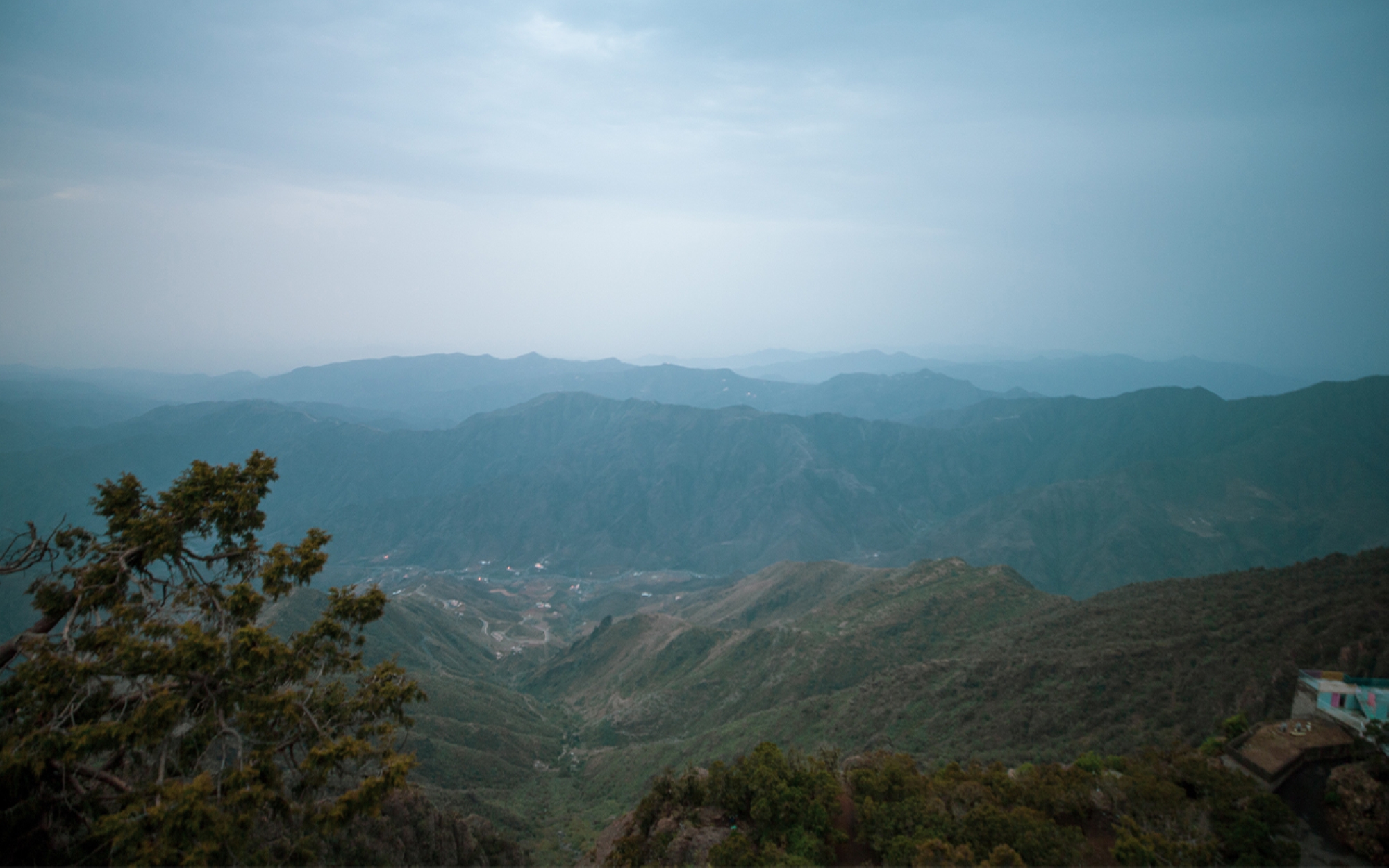
As-Sudah Park
Located at an altitude of about three thousand m above sea level, the summit of Jabal as-Sudah stands, approximately twenty-five km away from Abha City. Covering an area of around 883 ha (8.83 km), it includes the King Abdulaziz Park, which is distinguished by its unique environmental characteristics. The area receives the highest rainfall and possesses elevated humidity levels in the province. Dense forests of juniper trees flourish here. The vegetation varies between flat terrains and steep mountain edges. Deep within these slopes, a variety of wildlife thrives. On some of the carved rocks, one can observe writings and drawings, narrating tales from epochs exceeding three thousand years ago.
As-Sudah Park offers its visitors a plethora of services, including asphalt roads connecting the park to Abha City and the neighboring villages. It features pathways for natural sightseeing, car parking areas, picnic tables and benches, wooden bridges, camping areas, cooking and shopping spots, restrooms, and viewing platforms equipped with telescopic lenses to see the views of the Tihama plain, valleys, and nearby villages. The park also provides essential amenities like water, security, and electricity. Modern technology has been integrated into the park with the introduction of cable cars, which connect the Tihama region to the Sarawat Mountains. These cable cars consist of fourteen cabins, spanning a distance of about seven km while reaching a depth of around two thousand m.
New Abha
It is one of the tourist landmarks in the province, holding a significant tourist and economic position in Abha City. Covering an area of approximately four hundred thousand m², it overlooks the dam's lake and is surrounded by green gardens. It is connected to the Green Mountain via a cable car station, spanning about five km in length. This cable car system has the capacity to transport over 1,500 tourists per hour using its forty-eight cabins.
New Abha offers numerous services to its visitors. It boasts over thirty-five international games, sixteen restaurants and cafes, in addition to water games, entertainment centers, an exhibition center, two hotels, fifty villas, and 280 residential apartments, supplemented by residential resorts and private family seating areas.
Abha Summer Festival
It is an entertainment event initiated by the Aseer Development Authority under the slogan Above the Mountains, with its activities held at Sama Abha Park. The festival encompasses six entertainment and tourist areas: The Blue Stage, the Kids Area, the Carnival and Adventure Area, the Magic Village, the Retail and Market, and the Mifana Food Area.
The festival provides about two thousand parking spots in its vicinity, an additional three thousand parking spots at King Khalid University's grounds, and four hundred VIP parking spots. The festival also played a significant role in bolstering the local economy by providing around one thousand job opportunities for the region's residents in event management and organization.
Culture in Abha City
Qemam International Festival for Mountain Performance Arts
The Theater and Performing Arts Commission hosted the first edition of the Qemam International Festival for Mountain Performance Arts, with the participation of local folk groups, from January 9 to 15, 2022, at the King Khalid University Theater in Abha. The festival celebrated mountain performing arts, complemented by various arts, including culinary arts, fashion, and visual arts through exhibitions held at five venues: King Khalid University in Abha, Abha Literary Club, Al Mushayt Palaces, Al Abo Sarrah Palaces, and Malik Palace. The event showcased twenty different styles of mountain performance arts, with twelve folk groups representing various regions and peaks of Sarawat. A directive was issued for the second edition to be international, aiming to globally promote Saudi traditional heritage.
The second edition, launched on January 20, 2023, featured international participation and focused on introducing the archaeological and heritage sites of Aseer Province, while enhancing global awareness and appreciation of ancient arts and heritage in the Kingdom and the world. It is considered the first global festival specialized in mountain performing arts.
The festival featured approximately sixteen Saudi bands and fourteen international bands, showcasing around thirty-two mountain performance styles from both within and outside the Kingdom. The events took place across seven different locations in Aseer Province and included a variety of activities such as concerts, storytelling, village weddings, and traditional rituals.
The third edition of the festival kicked off on January 20, 2024, with an artistic concert featuring a mountain theme at the King Khalid University Theater in Abha. The event showcased local arts through a performing band. The festival took place across eight historic sites in Aseer Province: Basta al-Qabil, Shamsan Castle, Bin Adwan Historical Village, Malik Heritage Palace, Al Mushayt Palaces, Al Abo Sarrah Palaces, Abu Nuqtah al-Muthami, and Bin Hamsan Village. It featured performances by twenty Saudi bands and twenty-five international bands, presenting forty mountain styles in their traditional costumes. The third edition also introduced fifteen new performing bands, including four Saudi teams and eleven international teams, along with eight new mountain colors, bringing the total to forty distinct styles.
Al-Khutwa al-Janubiya (Southern Step) Festival
Within the Quality of Life program, one of the Saudi Vision 2030 realization programs, the Southern Step Festival was launched. Organized by the Ministry of Culture, it took place in the traditional square of Abha City on November 27, 2022. The festival saw participation from the music sector, performing arts, and fashion with the aim of highlighting the unique Aseeri Step dance.
The Southern Step Festival began with an opening operetta, synchronized with the rhythm of the Southern Step dance, and featured the singing of national poetic verses associated with the dance's tradition. The festival featured four main areas, including al-Khutwa al-Aseeriya Exhibition Area. This section showcased an exhibition focused on the history of al-Khutwa that dates back a thousand years. It highlighted twenty distinct melodies and traced its evolution from its origins as a war dance to its development into an art form passed down through generations. The Training Area included a theater space of one hundred to two hundred m² with an interactive screen floor, where visitors' al-Khutwa dance movements were transformed into illuminations. The 'Music and Cooking' Area features restaurants, cafes, folk instrument musicians, al-Khutwa dance bands, and models of traditional musical instruments. Lastly, the Poetic and Musical Evenings Area hosted poets and artists who delivered musical and poetic sessions, focusing on poems associated with al-Khutwa art form.
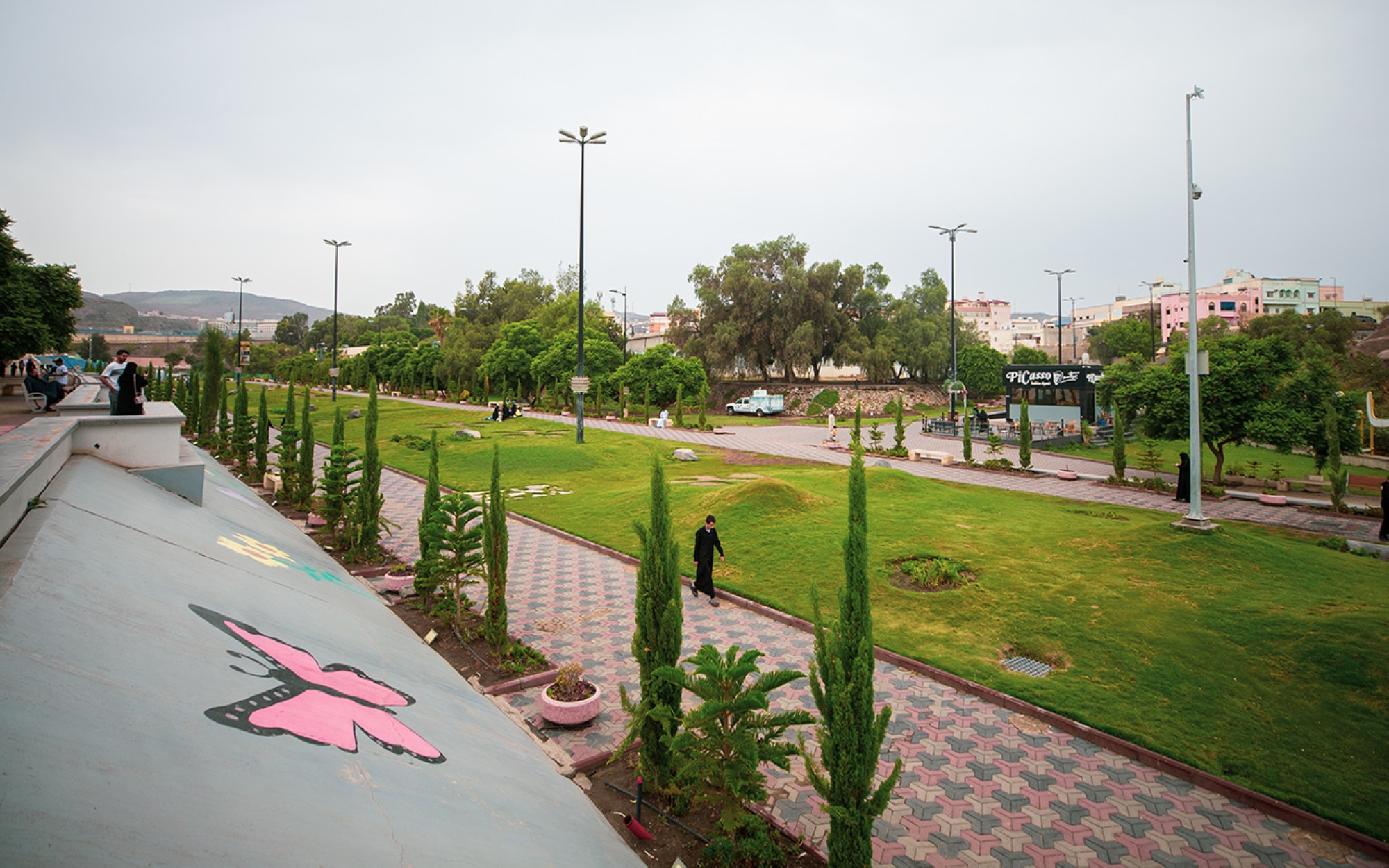
Art Street
This public event aims to promote the visual arts while showcasing creativity and talents. The Art Street is adorned with purple Jacarandas and vibrant colors from paintings, landmarks, facilities, or umbrellas. It features a dancing fountain and a lengthy walkway that stretches from the Abha Dam, passing by several government buildings and institutions. Numerous events are held there in mid-July each year, including concerts, competitions, live performances at the Art Street theater, restaurants and cafes, extreme sports, skateboarding, classic cars, and a vibrant flower carpet extending along the pedestrian area. Additionally, there are child-friendly activities like painting lessons, singing, performances, magic shows, and acting.
Al-Muftaha Village
It is located in the center of Abha City and is one of the tourist villages in the Kingdom. It attracts lovers of heritage arts, visual arts, photography, crafts, and handicrafts, making it an important creative and cultural center. The village consists of closely spaced houses with interior and exterior pathways, featuring thick mud walls built with the Ragaf technique to protect them from the rain and to observe the play of shadows on the facades of its buildings. The village has been renovated and restored, maintaining the style of the original old village structures.
In 1988, the then-Governor of Aseer Province, Prince Khalid al-Faisal, proposed the idea of exploiting the village for tourism and transforming it into a creative center dedicated to visual arts and photography, embracing local handicrafts and artisanship. In 1990, al-Muftaha Village was inaugurated. It included al-Muftaha Theater, one of the largest theaters in the Middle East, accommodating more than 3,500 spectators. It employs modern sound technologies, and it hosts celebrations, lectures, and seminars, in addition to cultural activities such as courses, poetry evenings, cultural events, and tourist activities. In 2019, the name of al-Muftaha Theater was changed to Artist Talal Maddah Theater.
The village features the three-story archaeological headquarters, which houses a substantial collection of Aseer artifacts; the King Fahd Cultural Center; and the Tuesday Market, one of the oldest traditional markets in Aseer Province. Designed in an oval shape, the market showcases local products and handicrafts. Additionally, the Fine Arts Village offers a venue for artists to engage in exhibitions and events, alongside various craft shops specializing in silver, antiques, and honey.
Abha Literary Club
Abha Cultural Club is a pioneering institution in discovering talents and introducing them to creative institutions. It was inaugurated with a complete board of directors and members in 1980. The club consists of several committees, including those for history, heritage, storytelling, poetry, media, and relations. The club has managed to encompass ideas and voices in their various forms. It played an active role in the literary and cultural movement in Aseer Province, attracting many from the area to join and participate in the club, and publishing the literary works of its members. The club dedicated significant space to women's contributions to culture and literature, as evident in its periodical Bayadir. It also set aside al-Khansa Hall for women to attend and participate in seminars, evening gatherings, and lectures.
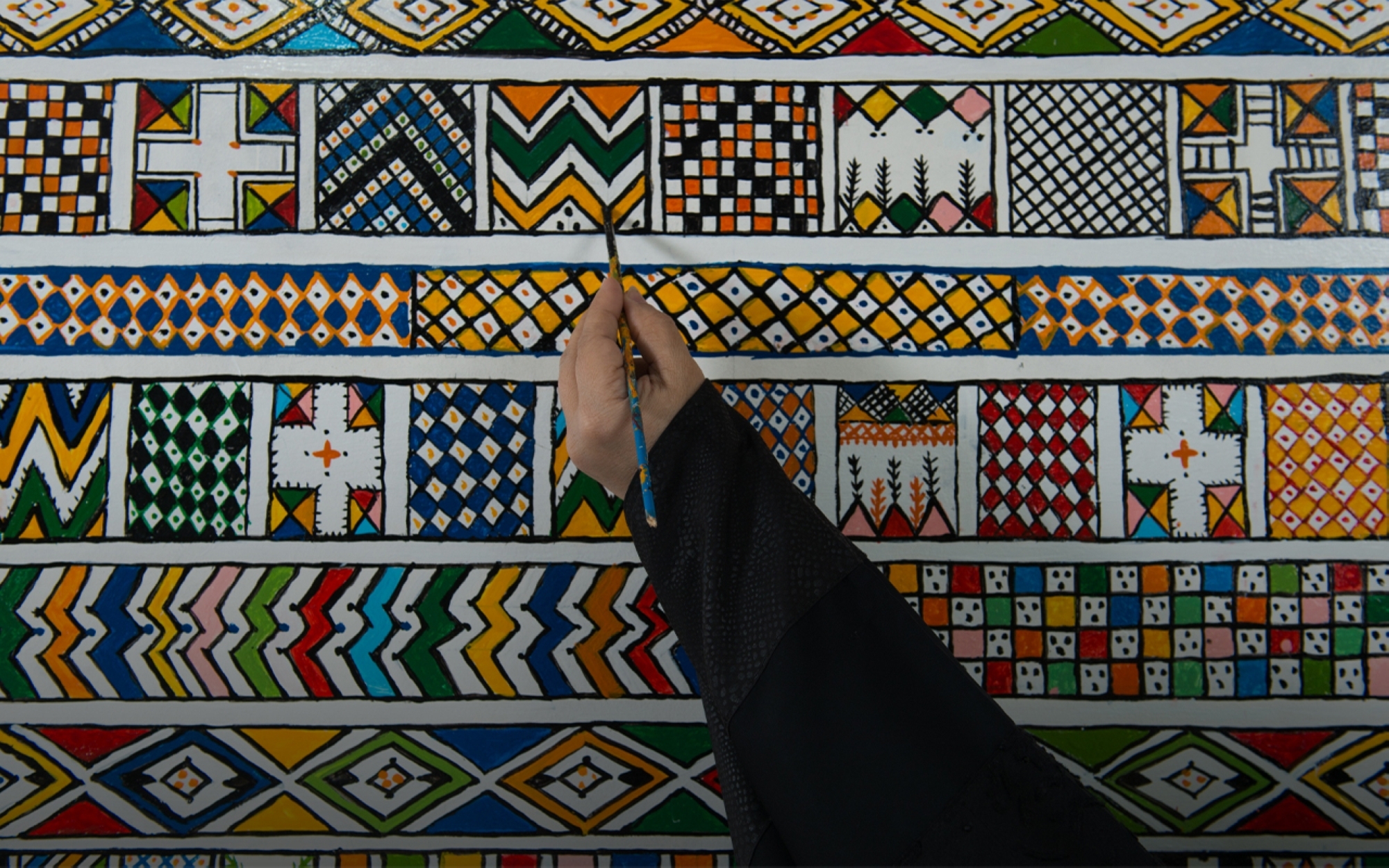
Arts in Abha City
Al-Qatt al-Aseeri
Al-Qatt al-Aseeri is an ancient art form that dates back hundreds of years. Women in Aseer Province use it to decorate the walls of their homes and household items with geometric patterns inspired by the surrounding environment. The word Qatt in Arabic dictionaries refers to line, carving, or cut. This art form consists of visual elements: Al-Banat, al-Aryaash, al-Maharib, al-Rukun, al-Balsana, al-Amshat, al-Ta'dhiq, Sankroli, al-Muthalath and al-Mukhamas, al-Kaff, and al-Shabaka. In late 2015, a mural of al-Qatt was displayed in the United Nations building in New York. It was executed by twelve women from Aseer Province and was titled Our Mothers' House, stretching to about eighteen m in length. In 2017, al-Qatt al-Aseeri art was inscribed on the Intangible Cultural Heritage List of the United Nations Educational, Scientific, and Cultural Organization (UNESCO).
Before beginning the beautification of the house walls, women would apply a white layer to the walls, a phase referred to as al-Taqteet. Following this, they would start painting geometric decorations using primary natural colors: red, yellow, black, and blue. These colors are prepared by the women of Aseer Province. They extract them from colored clays, or from powdered limestone, or from certain plants and fruits. To these colors, stabilizing and polishing agents are added. In recent times, ready-made colors in powder form have been used. These are mixed with water and stabilizing agents, or modern oil-based paints are used for coloring.
The art of al-Qatt has become intertwined with tourism in Aseer Province. Tourists prefer tools adorned with al-Qatt colors and made in Aseer Province. Most products now rely on this art, as it serves as an attraction in modern local markets and special museums for visitors. Among these products are souvenirs that mimic the region's heritage in a modern style. These include the manufacturing of small traditional dolls, sun and rain umbrellas, medals, women's handbags, keys, scarves, women's shawls, household ornaments, vases, and special household dining tools.
Al-Khutwa al-Aseeriya (Aseeri Step)
It is prominent in many regions south of the Kingdom, and its performance success relies on the harmony of human voices and the rhythm of footsteps. The performance technique, named after the practice itself, involves stepping forward and then stepping back in a regular rhythm as part of a line of performers. Al-Khutwa art encompasses singing traditional poetry alongside the rhythmic sounds of drums and footsteps. Occasionally, some performers within the lines may chant certain poetic verses.
The historical village of Tabab
Tabab is located northwest of Abha City, approximately twenty-five km away. It is an administrative center affiliated with the Emirate of Aseer Province. Its climate is characterized by mild temperatures in the summer and cold during the winter. The area encompasses over 150 villages, distributed between the Sha'ar slope, the Samaa slope, and parts of Tihama. The region is traversed by several valleys, the most famous of which are Wadi Tabab, al-Mughoth, Dubwai, Munaqa, and Rima. The area is dotted with a collection of mountains and peaks, such as Mount Tahlal, Lutid, Qarah, al-Namari, Khubr, Bashiyyi, al-Zuhari, and Rathba. Tabab is known for cultivating seasonal crops like wheat, barley, maize, and lentils, as well as all types of fruits and vegetables. This agriculture is supported by the rainfall during the spring and summer seasons and ancient wells that date back to earlier times.
Historically, Tabab has been renowned since the era of the First Saudi State, where it served as the capital of Aseer Province nearly three centuries ago. The administrative center of Tabab comprises various districts including Tabab itself, Tihan, Al Harith, al-Talada, al-Ghal, Al Bijad, al-Rafqatin, Al Shadadi, Al Asim, and Bani Ghanmi. The Tabab center boasts several landmarks, such as forts, castles, and historic palaces scattered across many of its villages. Some of these villages include al-Hadn, Zeina, al-Ghal, al-Masqawi, al-Waghl, Muzmah, Sharmah, Masaouli, and al-Zahra'.
Historical Tabab Mosque
It is one of the oldest historical mosques in Aseer Province and a significant heritage and historical landmark. It was established as a center for learning and teaching the Holy Quran, religious sciences, reading, and writing. It was commissioned by Imam Saud Bin Abdulaziz Bin Mohammed in 1806 in the village of Tabab, near Abha City. The mosque underwent restoration in 1998, funded by King Abdullah Bin Abdulaziz through al-Turath Foundation. It is located about twenty-eight km north of Abha City. It was built using local stones, and roofed with solid wood.
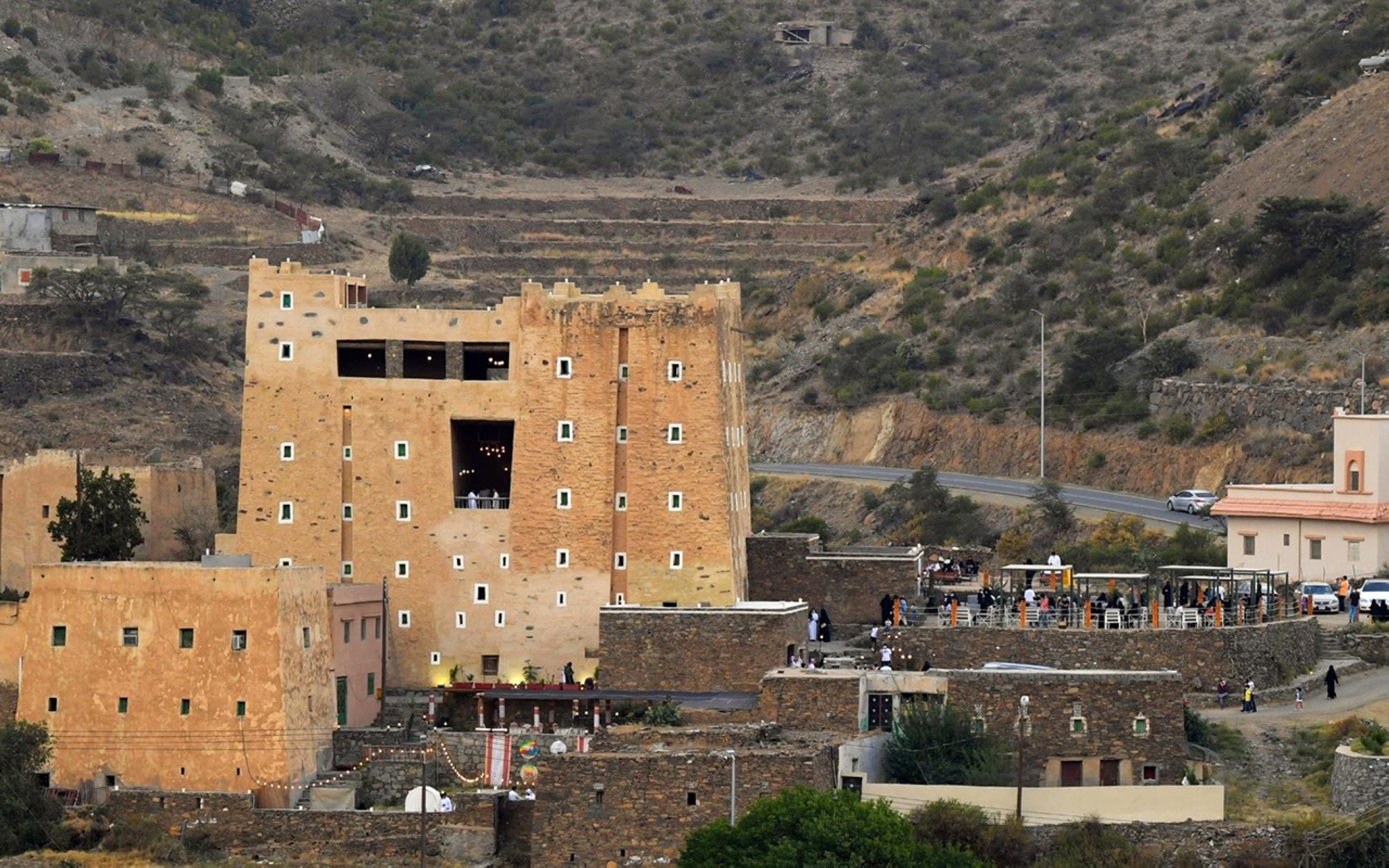
Abu Nuqtah al-Muthami
The palaces and fortresses of Al Abu Nuqtah al-Muthami are located on the banks of the Wadi Tahlal, within the administrative center of Tabab in Aseer Province. They cover an area of approximately four thousand m². The site boasts diverse facilities such as restaurants overlooking the village and its farms, service kiosks, souvenir gift shops, and a bakery.
The forts and palaces comprise six sites of varying sizes and heights, featuring a collection of tombs of different dimensions. These tombs, carved into a rain-resistant rocky mountain, range in depth from two to three m and in width from six to fifteen m. Some are situated beneath the forts and palaces, while others are deep within the rocky mountain. They were originally used for storing agricultural crops to preserve them for extended periods, particularly during times of war, drought, or agricultural cessation. Additionally, they served as hiding places for ammunition.
Related quizzes
Related articles


